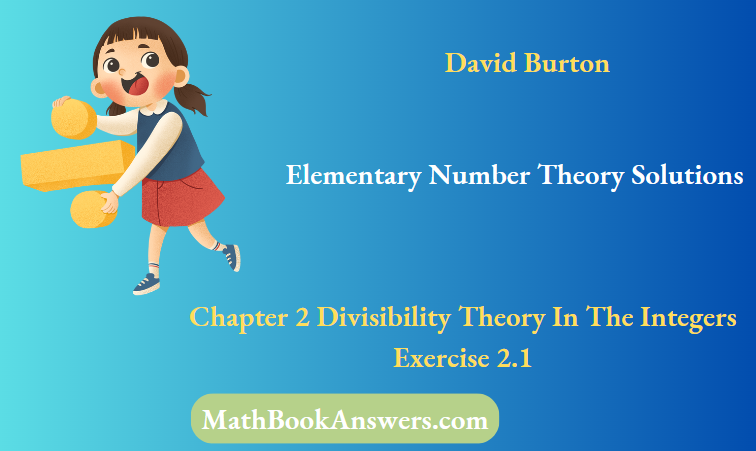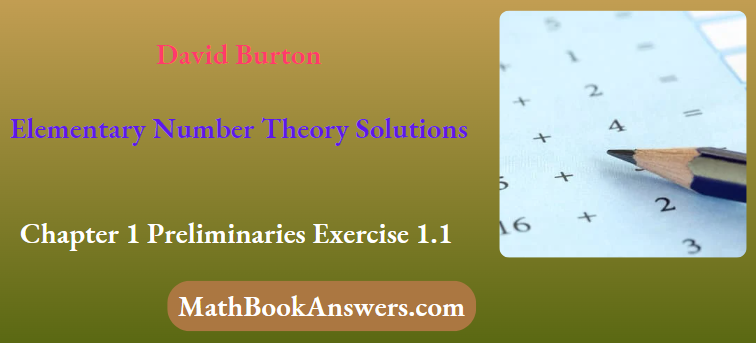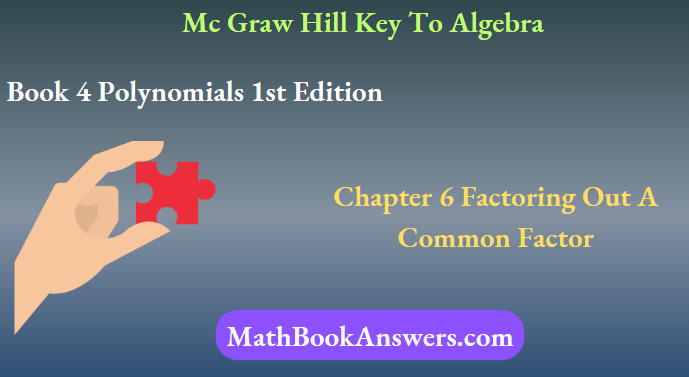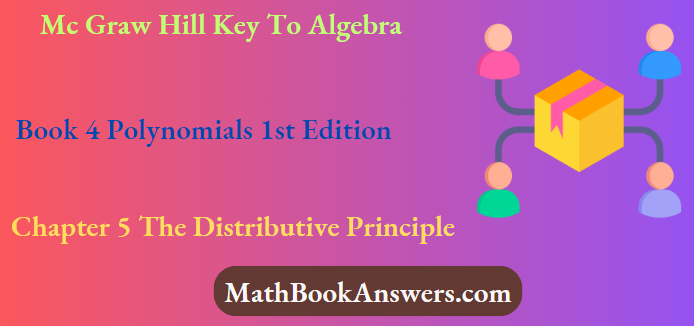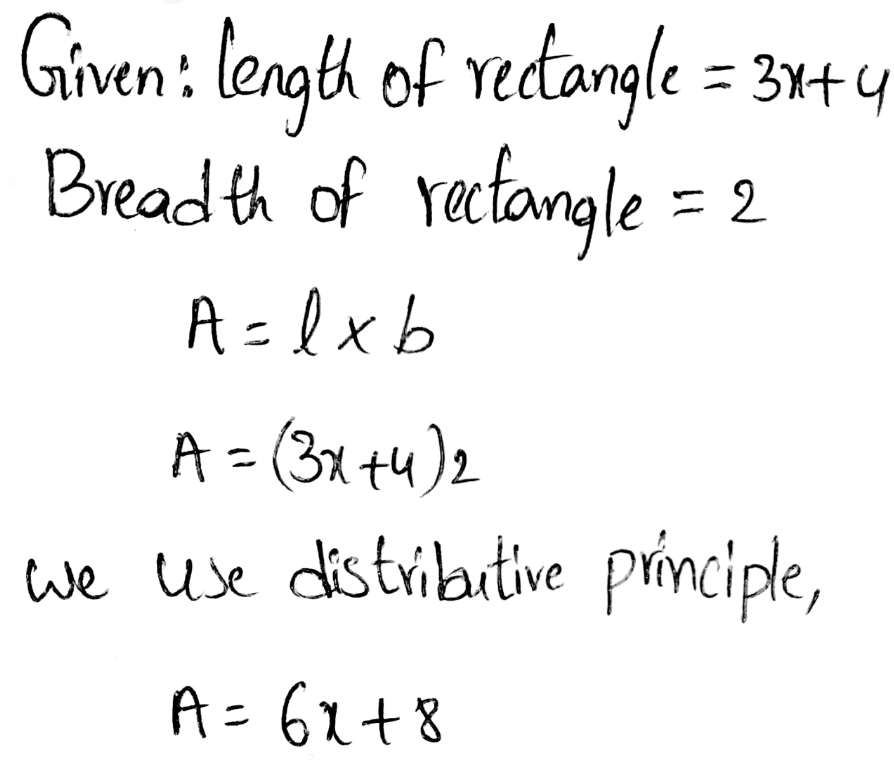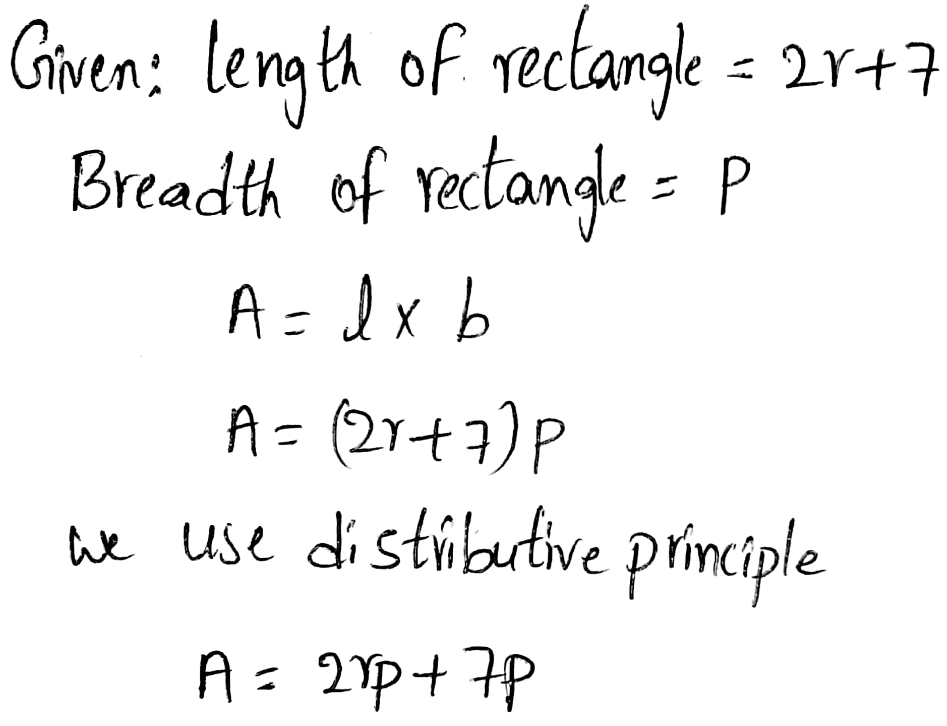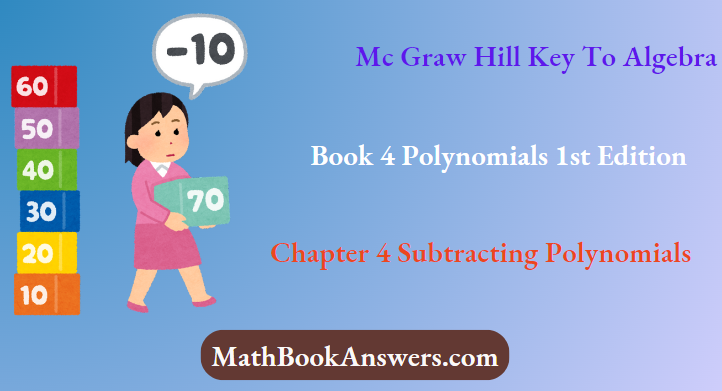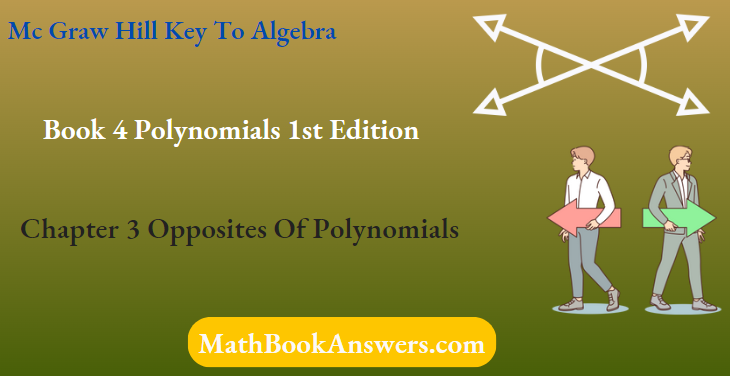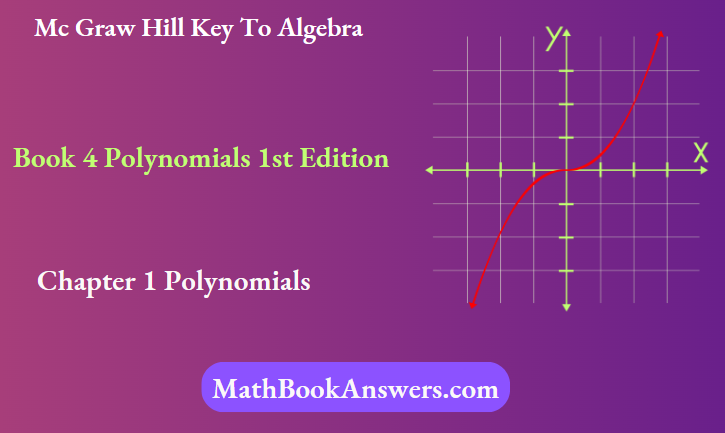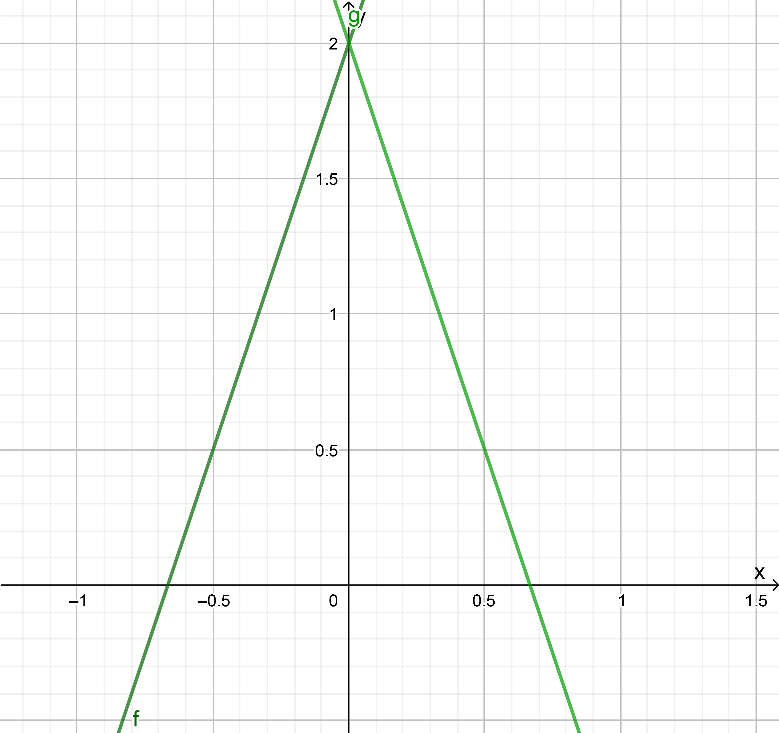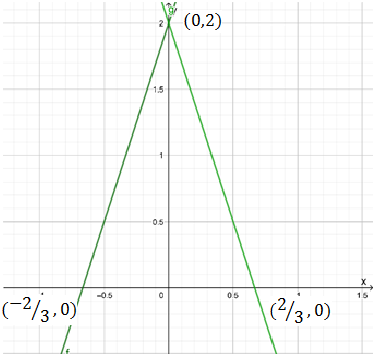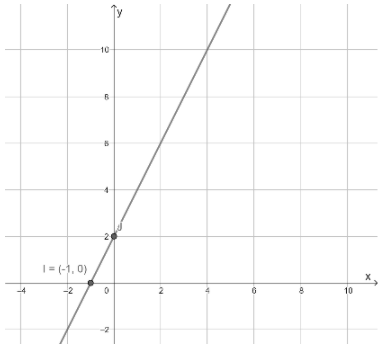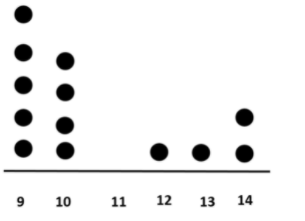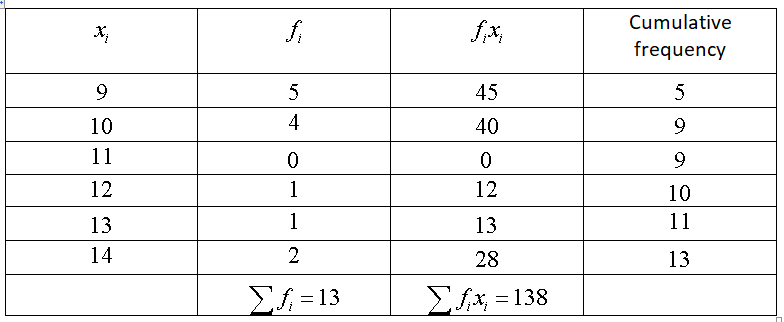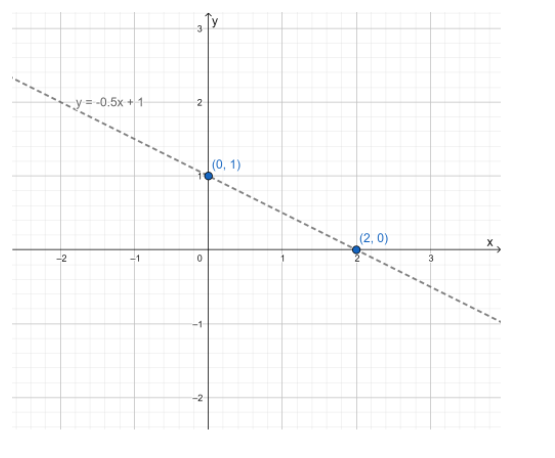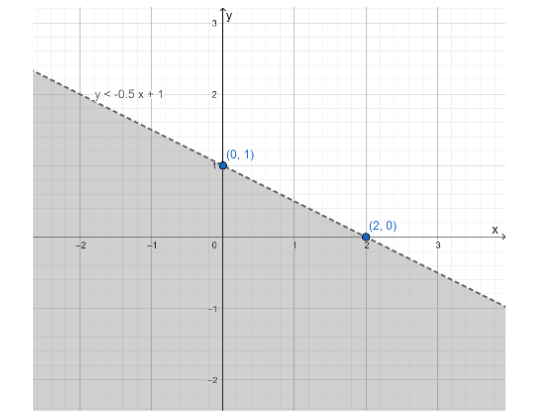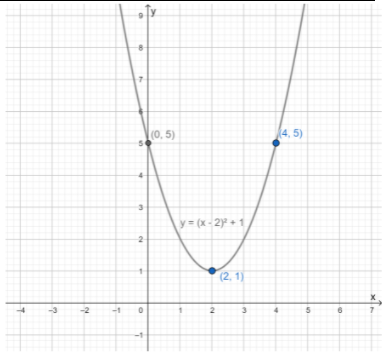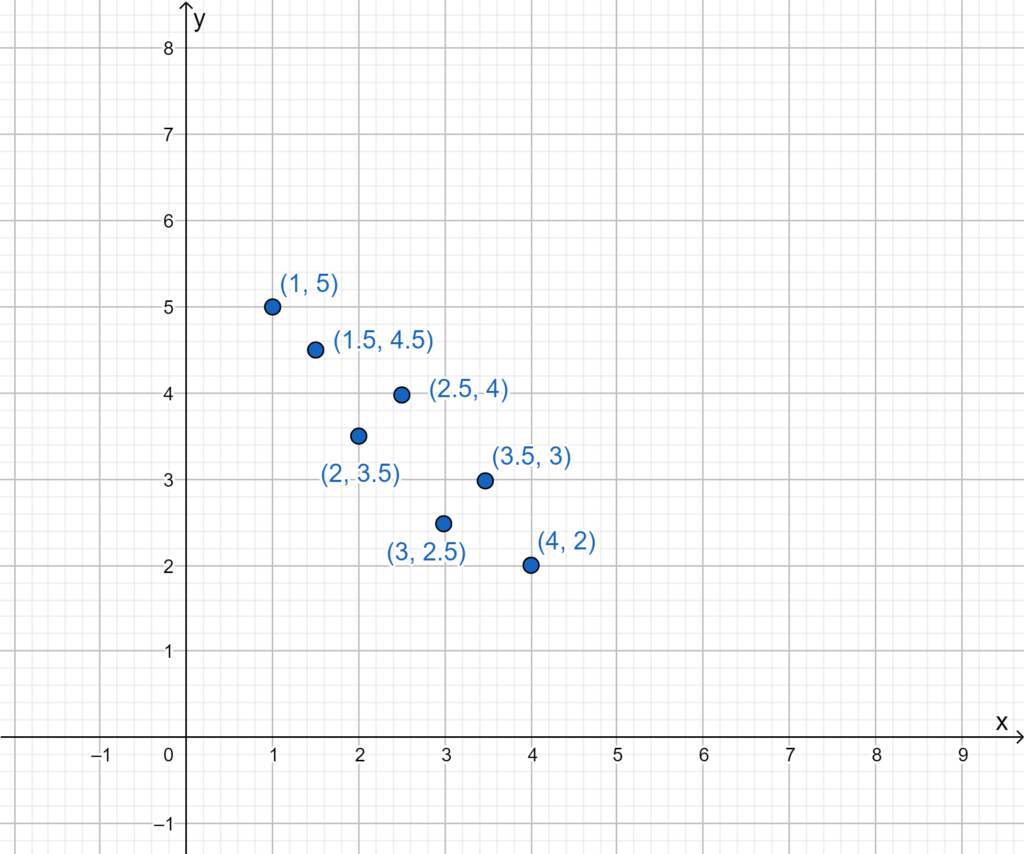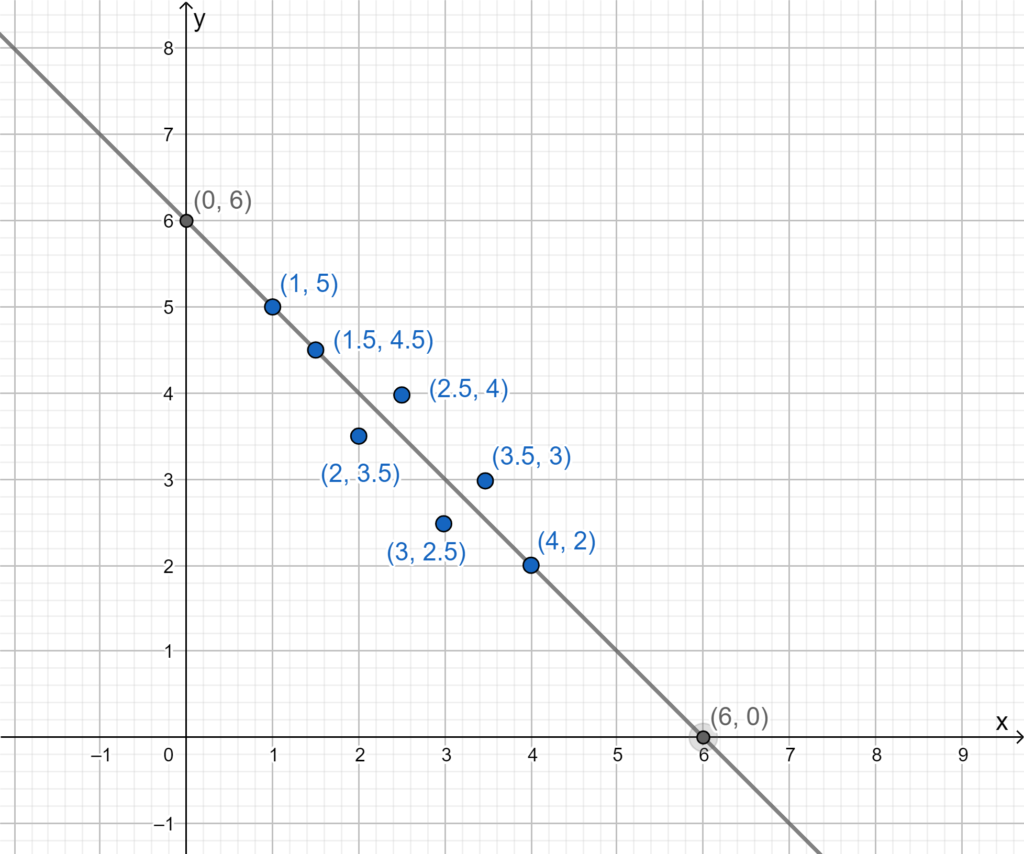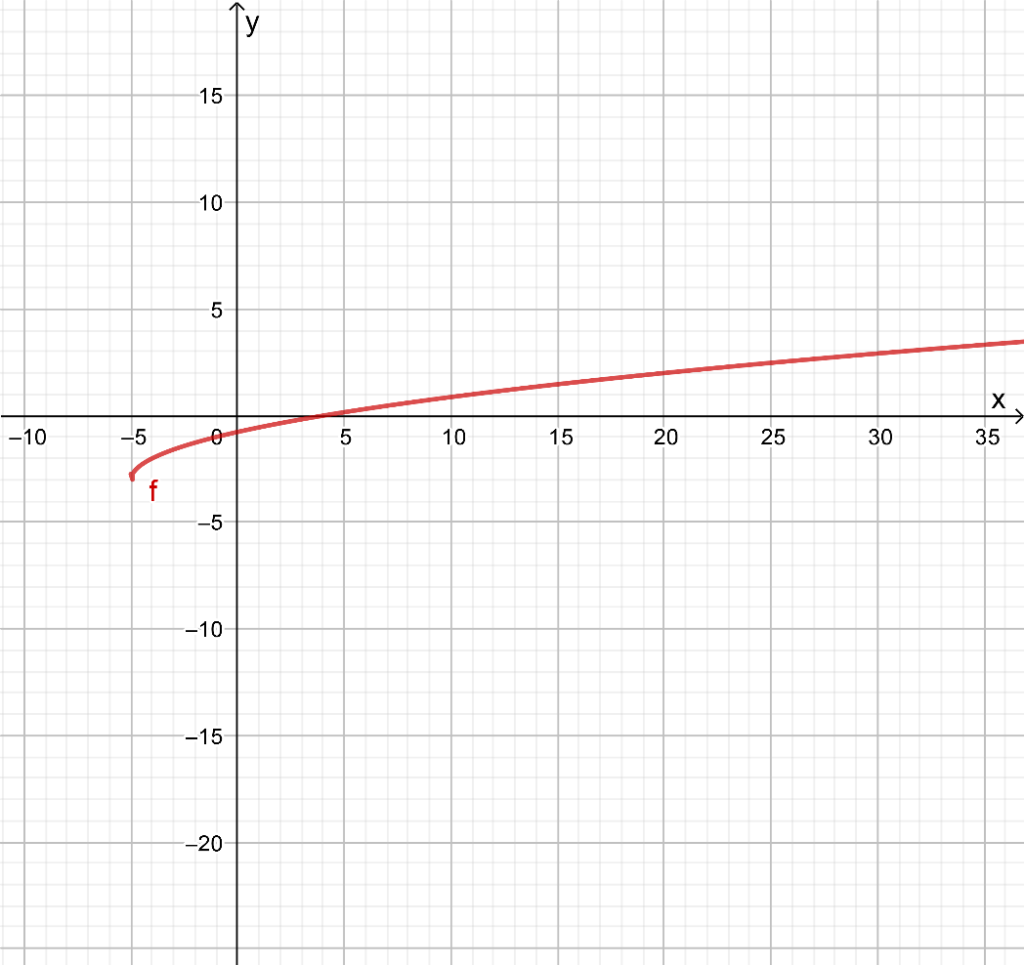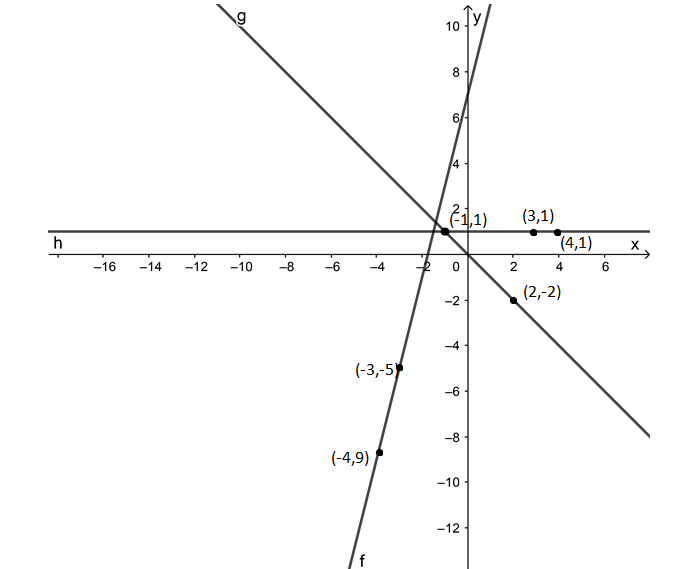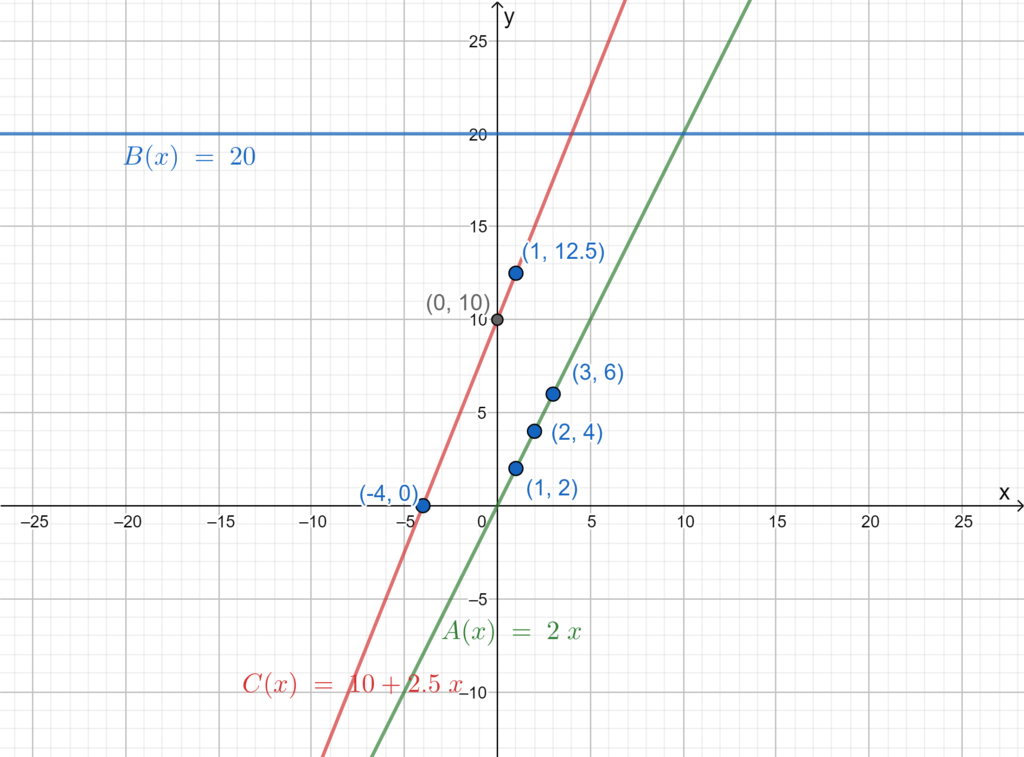Mc Graw Hill Key To Algebra Book 4 Polynomials 1st Edition Chapter 8 Multiplying And Factoring Polynomials
Page 21 Exercise 3 Answer
Question: Find the factors of the second-order degree polynomial x2 − 17x + 16?
Solution:
Given: x2 − 17x + 16
To find: factorize each into a product of two binomials.
Given that x2 − 17x + 16
First factorizing as 16 many different ways we can -16x-1,-8x-2,- 4x-4
While testing the combination -16x-1
So,
⇒ \(\begin{aligned}
& x^2-17 x+16 \\
\Rightarrow & x^2-x-16 x+16 \\
\Rightarrow & x(x-1)-16(x-1) \\
\Rightarrow & (x-1)(x-16)
\end{aligned}\)
Finally x2-17x+16=(x-1)(-16)
Thus, the factorization of the second degree polynomial x2 − 17x + 16 into a product of two binomials is (x−1)(x−16)
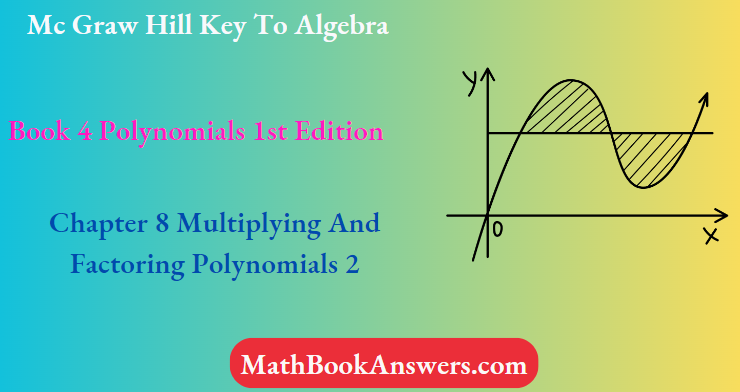
Page 21 Exercise 4 Answer
Question: Find the factors of the second-order degree polynomial x2 − 8x + 15?
Solution:
Given: x2 − 8x + 15
To find: factorize each into a product of binomials.
Given that x²-18x+15
First factorizing 15 as many different ways
We can -15x-1,-3x-5
While testing the combinations, 3x-5
So, x²-8x+15
⇒ \(\begin{aligned}
& \Rightarrow x^2-5 x-3 x+15 \\
& \Rightarrow x(x-5)-3(x-5) \\
& \Rightarrow(x-3)(x-5)
\end{aligned}\)
Finally, x²-8x+15=(x-3)(x-5)
Thus, the factorization of the second degree polynomial x2 − 8x + 15 into a product of two binomials is (x−3)(x−5)
Question: Find the factors of the second-order degree polynomial x2 − 16x + 15?
Solution:
Page 21 Exercise 5 Answer
Given: x2 − 16x + 15
To find: factorize each into a product of two binomials.
Given that x2-16x+15
First factorizing 15 as many different ways
We can -15x-1,-3x-5
while testing the combinations, -3x-5
So x2-8x+15
⇒ x2-5x-3x+15
⇒ x(x-5)-3(x-5)
⇒ (x-3)(x-5)
Finally, x2-8x+15=(x-3)(x-5)
Thus, the factorization of second degree polynomial x2 − 16x + 15 into a product of two binomials is (x−1)(x−5)
Mcgraw Hill Key To Algebra Book 4 Chapter 8 Part 2 Solutions
Mc Graw Hill Key To Algebra Book 4 Polynomials 1st Edition Chapter 8 Multiplying And Factoring Polynomials 2 Page 21 Exercise 6 Answer
Question: Find the factors of the second-order degree polynomial x2 − 17x + 72?
Solution:
Given: x2 − 17x + 72
To find: factorize each into a product of two binomials.
Given that x2-17x+72
First factorizing 72 as many different ways
we can -36x-2,-24x-3,-9x-8
while testing the combinations, -9x-8
so x²-17x+72
⇒ \(\begin{aligned}
& \Rightarrow x^2-9 x-8 x+72 \\
& \Rightarrow x(x-9)-8(x-9) \\
& \Rightarrow(x-8)(x-9)
\end{aligned}\)
Finally, x2-17x+72=(x-9)(x-8)
Thus, the factorization of second degree polynomial x2 − 17x + 72 into a product of two binomials is (x−9)(x−8)
Page 21 Exercise 8 Answer
Question: Find the factors of the polynomial x2 + 3x − 28?
Solution:
Given: x2 + 3x − 28
To find: factorize each into a product of two binomials.
Given that x2+3x-28
First factorising 28 as many different ways
we can 14x-2,7x-4
while testing the combinations, 7x-4
So, x2+3x-28
⇒ \(\begin{aligned}
& \Rightarrow x^2-7 x+4 x-28 \\
& \Rightarrow x(x-7)+4(x-7) \\
& \Rightarrow(x+4)(x-7)
\end{aligned}\)
Finally, x²+3x-28=(x+4)(X-7)
So. the factorization of second-degree polynomial x2 + 3x − 28 = (x+7)(x−4) is a product of two binomials.
Mc Graw Hill Key To Algebra Book 4 Polynomials 1st Edition Chapter 8 Multiplying And Factoring Polynomials 2 Page 21 Exercise 9 Answer
Question: Find the factors of the polynomial x2 − 2x − 24?
Solution:
Given: x2 − 2x − 24
To find: factorize each into the product of two binomials.
Given that x²-2x-24
first factorizing 24 as many different ways
we can -24×1, -12×2,-6×4
So, x²-2x-24
⇒ \(\begin{aligned}
& \Rightarrow x^2-6 x+4 x-24 \\
& \Rightarrow x(x-6)+4(x-6) \\
& \Rightarrow(x+4)(x-6)
\end{aligned}\)
Finally, x2-2x-24=(x-6)(x+4)
Thus, factorization of second degree polynomial x2 − 2x − 24 = (x−6)(x+4) is a product of two binomials.
Page 21 Exercise 10 Answer
Question: Find the factors of the polynomial x2 − 2x − 24?
Solution:
We have been given a polynomial x2 + 2x − 24 and we have to factorize it.
Given polynomial: x²+2x-24
\(\begin{aligned}
x^2+2 x-24 & =x^2+6 x-4 x-24 \\
& =x(x+6)-4(x+6) \\
& =(x-4)(x+6)
\end{aligned}\)
The factors of the polynomial x2 + 2x − 24 are (x−4) and (x+6)
Page 21 Exercise 11 Answer
Question: Find the factors of the polynomial x2 + 8x − 20?
Solution:
We have been given a polynomial x2 + 8x − 20 and we have to factorize it.
Given polynomial: x²-8x-20
⇒ \(\begin{aligned}
x^2-8 x-20 & =x^2-10 x+2 x-20 \\
& =x(x-10)+2(x-10) \\
& =(x+2)(x-10)
\end{aligned}\)
The polynomial x2 + 8x – 20 are (x-2) and (x+10)
Page 21 Exercise 12 Answer
Question: Find the factors of the polynomial x2 + 8x − 20?
Solution:
We have been given a polynomial x2 − 8x − 20 and we have to factorize it.
Given polynomial: x²+8x-20
⇒ \(\begin{aligned}
x^2+8 x-20 & =x^2+10 x-2 x-20 \\
& =x(x+10)-2(x+10) \\
& =(x-2)(x+10)
\end{aligned}\)
The factors of the polynomial x2 − 8x − 20 are (x+2) and (x−10)
Page 21 Exercise 1 Answer
Question: Find the factors of the polynomial x2 − 16?
Solution:
We have been given a polynomial x2 − 16 and we have to factorize it.
Given polynomial: x2-16
x²-16=x²-4²
=(x+4)(x-4)
[since (a²-b²) = (a+b)(a-b)]
The factors of the polynomial x2 – 16 are (x+4) and (x-4).
Key To Algebra Book 4 Multiplying And Factoring Polynomials Part 2 Answers
Mc Graw Hill Key To Algebra Book 4 Polynomials 1st Edition Chapter 8 Multiplying And Factoring Polynomials 2 Page 21 Exercise 2 Answer
Question: Find the factors of the polynomial x2 − 25?
Solution:
We have been given a polynomial x2 − 25 and we have to factorize it.
Given polynomial: x2-25
x²-25=x²-5²
=(x+5)(x-5)
[since (a²-b²) = (a+b)(a-b)]
The factors of the polynomial x2 – 25 are (x-5) and (x+5).
Page 21 Exercise 3 Answer
Question: Find the factors of the polynomial x2 − 81?
Solution:
We have been given a polynomial x2 − 81 and we have to factorize it.
Given polynomial: x2-81
x²-81=x²-9²
=(x+9)(x-9)
[since (a²-b²) = (a+b)(a-b)]
The factors of the polynomial x2 – 81 are (x+9) and (x-9).
Page 21 Exercise 4 Answer
Question: Find the factors of the polynomial x2 − 4?
Solution:
We have been given a polynomial x2 − 4 and we have to factorize it.
Given polynomial: x2-4
x²-4=x²-2²
=(x+2)(x-2)
[since (a²-b²) = (a+b)(a-b)]
The factors of the polynomial x2 – 4 are (x+2) and (x-2).
Mc Graw Hill Key To Algebra Book 4 Polynomials 1st Edition Chapter 8 Multiplying And Factoring Polynomials 2 Page 21 Exercise 5 Answer
Question: Find the factors of the polynomial x2 − 1?
Solution:
We have been given a polynomial x2 − 1 and we have to factorize it.
Given polynomial: x2-1
x²-1=x²-1²
=(x+1)(x-1)
[since (a²-b²) = (a+b)(a-b)]
The factors of the polynomial x2 – 1 are (x+1) and (x-1).
Page 21 Exercise 6 Answer
Question: Find the factors of the polynomial x2 − 100?
Solution:
We have been given a polynomial x2 − 100 and we have to factorize it.
Consider that:
Given polynomial: x2-100
Consider that:
A²-b²=(a+b)(a-b)
x²-100=x²-10²
=(x+10)(x-10)
[since (a²-b²) = (a+b)(a-b)]
The factors of the polynomial x2 − 100 are (x+10) and (x−10).
Page 22 Exercise 2 Answer
Question: Find the factors of the polynomial x2 − 4x − 45?
Solution:
The given polynomial is x2 − 4x − 45.
The objective is to find the factor of the given polynomial.
The given polynomial is x²-4x-45
⇒ \(\begin{aligned}
x^2-4 x-45 & =x^2-(9-5) x-45 \\
& =x^2-9 x+5 x-45 \\
& =x(x-9)+5(x-9) \\
& =(x+5)(x+9)
\end{aligned}\)
Hence, the factor of the polynomial, x2 − 4x − 45 is (x+5)(x−9).
Mc Graw Hill Key To Algebra Book 4 Polynomials 1st Edition Chapter 8 Multiplying And Factoring Polynomials 2 Page 22 Exercise 3 Answer
Question: Find the factors of the polynomial x2 + 18x + 45?
Solution:
The given polynomial is x2 + 18x + 45.
The objective is to find the factor of the given polynomial.
The given polynomial x²+18x+45
The polynomial,
x²+18x+45= x²+(15+3)x+45
=x²+15x+3x+45
=x(X+15)+3(x+15)
=(X+3)(x+15)
Now, check the answer
(x+3)(x+15)=x²+15x+3x+45
=x²+18x+45
Hence, the factor of the polynomial, x2 + 18x + 45 is (x+3)(x+15).
Page 22 Exercise 4 Answer
Question: Find the factors of the polynomial x2 − 12x − 45?
Solution:
The given polynomial is x2 − 12x − 45.
The objective is to find the factor of the given polynomial.
The given polynomial is x2-12x-45
The polynomial
x²-12x-45= x2-(15-3)x-45
=x2-15x+3x-45
=x(x-15)+3(x-15)
Now, check the answer
(x+3)(x-15)=x2-15x+3x-45
=x²-12x-45
Hence, the factor of the polynomial, x2 – 12x – 45 is (x+3)(x-15).
Mc Graw Hill Key To Algebra Book 4 Polynomials 1st Edition Chapter 8 Multiplying And Factoring Polynomials 2 Page 22 Exercise 5 Answer
Question: Find the factors of the polynomial x2 − 14x + 45?
Solution:
The given polynomial is x2 − 14x + 45.
The objective is to find the factor of the given polynomial.
The given polynomial is 2-14x+45
The polynomial,
⇒ \(\begin{aligned}
x^2-14 x+45 & =x^2-(9+5) x+45 \\
& =x^2-9 x-5 x+45 \\
& =x(x-9)-5(x-9) \\
& =(x-5)(x-9)
\end{aligned}\)
Now, check the answer
⇒ \(\begin{aligned}
(x-5)(x-9) & =x^2-9 x-5 x+45 \\
& =x^2-14 x+45
\end{aligned}\)
Hence, the factor of the polynomial, x2 − 14x + 45 is (x−5)(x−9).
Page 22 Exercise 6 Answer
Question: Find the factors of the polynomial x2 + 12x − 45?
Solution:
The given polynomial is x2 + 12x − 45.
The objective is to find the factor of the given polynomial.
The given polynomial is x²+12x-45
The polynomial,
⇒ \(\begin{aligned}
x^2+12 x-45 & =x^2+(15-3) x-45 \\
& =x^2+15 x-3 x-45 \\
& =x(x+15)-3(x+15) \\
& =(x-3)(x+15)
\end{aligned}\)
Now, check the answer
⇒ \(\begin{aligned}
(x-3)(x+15) & =x^2+15 x-3 x-45 \\
& =x^2+12 x-45
\end{aligned}\)
Hence, the factor of the polynomial, x2 + 12x − 45 is (x−3)(x+15).
Mc Graw Hill Key To Algebra Book 4 Polynomials 1st Edition Chapter 8 Multiplying And Factoring Polynomials 2 Page 22 Exercise 7 Answer
Question: Find the factors of the polynomial x2 + 4x − 45?
Solution:
The given polynomial is x2 + 4x − 45.
The objective is to find the factor of the given polynomial.
The given polynomial is x²+4x-45
The polynomial
⇒ \(\begin{aligned}
x^2+4 x-45 & =x^2+(9-5) x-45 \\
& =x^2+9 x-5 x-45 \\
& =x(x+9)-5(x+9) \\
& =(x-5)(x+9)
\end{aligned}\)
Now, check the answer
⇒ \(\begin{aligned}
(x-5)(x+9) & =x^2+9 x-5 x-45 \\
& =x^2+4 x-45
\end{aligned}\)
Hence, the factor of the polynomial, x2 + 4x − 45 is (x−5)(x+9).
Page 22 Exercise 8 Answer
Question: Find the factors of the polynomial x2 − 18x + 45?
Solution:
The given polynomial is x2 − 18x + 45.
The objective is to find the factor of the given polynomial.
The given polynomial is x²-18x+45
The polynomial,
⇒ \(\begin{aligned}
x^2-18 x+45 & =x^2-(15+3) x+45 \\
& =x^2-15 x-3 x+45 \\
& =x(x-15)-3(x-15) \\
& =(x-3)(x-15)
\end{aligned}\)
Now, check the answer
⇒ \(\begin{aligned}
(x-3)(x-15) & =x^2-15 x-3 x+45 \\
& =x^2-18 x+45
\end{aligned}\)
Hence, the factor of the polynomial, x2 − 18x + 45 is (x−3)(x−15).
Page 22 Exercise 10 Answer
Question: Find the factors of the polynomial x2 − 44x − 45?
Solution:
The given polynomial is x2 − 44x − 45.
The objective is to find the factor of the given polynomial.
The given polynomial is x²-44x-45
The polynomial
⇒ \(\begin{aligned}
x^2-44 x-45 & =x^2-(45-1) x-45 \\
& =x^2-45 x+x-45 \\
& =x(x-45)+1(x-45) \\
& =(x+1)(x-45)
\end{aligned}\)
Now, check the answer
(x+1)(x-45)=x²-45x+x-45
=x²-44x-45
Hence, the factor of the polynomial, x2 − 44x − 45 is (x+1)(x−45).
Mc Graw Hill Key To Algebra Book 4 Polynomials 1st Edition Chapter 8 Multiplying And Factoring Polynomials 2 Page 22 Exercise 11 Answer
Question: Find the factors of the polynomial x2 + 44x − 45?
Solution:
The given polynomial is x2 + 44x − 45.
The objective is to find the factor of the given polynomial.
The given polynomial is x²+44x-45 the polynomial,
⇒ \(\begin{aligned}
x^2+44 x-45 & =x^2+(45-1) x-45 \\
& =x^2+45 x-x-45 \\
& =x(x+45)-(x+45) \\
& =(x-1)(x+45)
\end{aligned}\)
Now, check the answer
⇒ \(\begin{aligned}
(x-1)(x+45) & =x^2+45 x-x+45 \\
& =x^2+44 x-45
\end{aligned}\)
Hence, the factor of the polynomial, x2 + 44x − 45 is (x−1)(x+45).
Page 22 Exercise 12 Answer
Question: Find the factors of the polynomial x2 − 46x + 45?
Solution:
The given polynomial is x2 − 46x + 45.
The objective is to find the factor of the given polynomial.
The polynomial
⇒ \(\begin{aligned}
x^2-46 x+45 & =x^2-(45+1) x+45 \\
& =x^2-45 x-x+45 \\
& =x(x-45)-1(x-45) \\
& =(x-1)(x-45)
\end{aligned}\)
Now, check the answer
⇒ \(\begin{aligned}
(x-1)(x-45) & =x^2-45 x-x+45 \\
& =x^2-46 x+45
\end{aligned}\)
Hence, the factor of the polynomial, x2 − 46x + 45 is (x−1)(x−45).
Page 22 Exercise 13 Answer
Question: Find the factors of the polynomial a2 + 17a + 72?
Solution:
The given polynomial is a2 + 17a + 72.
The objective is to find the factor of the given polynomial.
The polynomial,
⇒ \(\begin{aligned}
a^2+17 a+72 & =a^2+(8+9) a+72 \\
& =a^2+8 a+9 a+72 \\
& =a(a+8)+9(a+8) \\
& =(a+8)(a+9)
\end{aligned}\)
Now, check the answer
(a+8)(a+9)=a²+9a+8a+72
=a²+17a+72
Hence, the factor of the polynomial, a2 + 17a + 72 is (a+8)(a+9).
Mc Graw Hill Key To Algebra Book 4 Polynomials 1st Edition Chapter 8 Multiplying And Factoring Polynomials 2 Page 22 Exercise 14 Answer
Question: Find the factors of the polynomial a2 − a − 72?
Solution:
The given polynomial is a2 − a − 72.
The objective is to find the factor of the given polynomial.
⇒ \(\begin{aligned}
a^2-a-72 & =a^2-(9-8) a-+2 \\
& =a^2-9 a+8 a-72 \\
& =a(a-9)+8(a-9) \\
& =(a+8)(a-9)
\end{aligned}\)
Now, check the answer
⇒ \(\begin{aligned}
(a+8)(a-a) & =a^2-9 a+8 a-72 \\
& =a^2-a-72
\end{aligned}\)
Hence, the factor of the polynomial, a2 − a − 72 is (a+8)(a−9).
Page 22 Exercise 16 Answer
Question: Find the factors of the polynomial x2 − 5x + 4?
Solution:
The given polynomial is x2 − 5x + 4.
The objective is to find the factor of the given polynomial.
⇒ \(\begin{aligned}
x^2-5 x+4 & =x^2-(4+1) x+4 \\
& =x^2-4 x-x+4 \\
& =x(x-4)-(x-4) \\
& =(x-1)(x-4)
\end{aligned}\)
Now, check the answer
⇒ \(\begin{aligned}
(x-1)(x-4) & =x^2-4 x-x+4 \\
& =x^2-5 x+4
\end{aligned}\)
Hence, the factor of the polynomial, x2 − 5x + 4 is (x−1)(x−4).
Page 22 Exercise 17 Answer
Question: Find the factors of the polynomial x2 + 3x − 4?
Solution:
The given polynomial is x2 + 3x − 4.
The objective is to find the factor of the given polynomial.
⇒ \(\begin{aligned}
x^2-5 x+4 & =x^2-(4+1) x+4 \\
& =x^2-4 x-x+4 \\
& =x(x-4)-(x-4) \\
& =(x-1)(x-4)
\end{aligned}\)
Hence, the factor of the polynomial, x2 + 3x − 4 is (x−1)(x+4).
Mc Graw Hill Key To Algebra Book 4 Polynomials 1st Edition Chapter 8 Multiplying And Factoring Polynomials 2 Page 22 Exercise 18 Answer
Question: Find the factors of the polynomial x2 + 4x − 12?
Solution:
The given polynomial is x2 + 4x − 12.
The objective is to find the factor of the given polynomial.
The Given polynomial x²+4x-12 the polynomial,
⇒ \(\begin{aligned}
x^2+4 x-12 & =x^2+(6-2) x-12 \\
& =x^2+6 x-2 x-12 \\
& =x(x+6)-2(x+6) \\
& =(x-2)(x+6)
\end{aligned}\)
Now check the answer
⇒ \(\begin{aligned}
(x-2)(x+6) & =x^2+6 x-2 x-12 \\
& =x^2+4 x-12
\end{aligned}\)
Hence, the factor of the polynomial, x2 + 4x − 12 is (x−2)(x+6).
Page 22 Exercise 19 Answer
Question: Find the factors of the polynomial x2 − 4x + 4?
Solution:
The given polynomial is x2 − 4x + 4.
The objective is to find the factor of the given polynomial.
The given polynomial is x2-4x+4
⇒ \(\begin{aligned}
x^2-4 x+4 & =x^2-(2+2) x+4 \\
& =x^2-2 x-2 x+4 \\
& =x(x-2)-2(x-2) \\
& =(x-2)(x-2) \\
& =(x-2)^2
\end{aligned}\)
Hence, the factor of the polynomial, x2 − 4x + 4 is (x−2)2.
Page 22 Exercise 20 Answer
Question: Find the factors of the polynomial s2 − 10s + 25?
Solution:
The given polynomial is s2 − 10s + 25.
The objective is to find the factor of the given polynomial.
The given polynomial is s2-10s+25
The polynomial,
⇒ \(\begin{aligned}
s^2-10 s+25 & =s^2-(5+s) s+25 \\
& =s^2-5 s-5 s+25 \\
& =s(s-5)-5(s-5) \\
& =(s-5)(s-5) \\
& =(s-5)^2
\end{aligned}\)
Now, check the answer
(s-5)²=s³-10s+25
[since (a-b)²=a²-2ab+b²]
Hence, the factor of the polynomial, s2 − 10s + 25 is (s−5)2.
Mc Graw Hill Key To Algebra Book 4 Polynomials 1st Edition Chapter 8 Multiplying And Factoring Polynomials 2 Page 22 Exercise 21 Answer
Question: Find the factors of the polynomial y2 − 6y + 9?
Solution:
The given polynomial is y2 − 6y + 9.
The objective is to find the factor of the given polynomial.
The given polynomial is y²-6y+9
The poynomial
⇒ \(\begin{aligned}
y^2-6 y+9 & =y^2-(3+3) y+9 \\
& =y^2-3 y-3 y+9 \\
& =y(y-3)-3(y-3) \\
& =(y-3)(y-3) \\
& =(y-3)^2
\end{aligned}\)
Now, check the answer
(y-3)²=y²-6y+9
[since(a-b)²=a²-2ab+b²]
Hence, the factor of the polynomial, y2 − 6y + 9 is (y−3)2.
Page 22 Exercise 22 Answer
Question: Find the factors of the polynomial a2 + 2a + 1?
Solution:
The given polynomial is a2 + 2a + 1.
The objective is to find the factor of the given polynomial.
The given polynomial is a²+2a+1
The polynomial,
⇒ \(\begin{aligned}
a^2+2 a+1 & =a^2+(1+1) a+1 \\
& =a^2+a+a+1 \\
& =a(a+1)+(a+1) \\
& =(a+1)(a+1) \\
& =(a+1)^2
\end{aligned}\)
Now, check the answer
(a+1)²=a2+2a+1
(since (a+b)²=a²+2ab+b²]
Hence, the factor of the polynomial, a2 + 2a + 1 is (a+1)2.
Page 22 Exercise 24 Answer
Question: Find the factors of the polynomial c2 − c − 2?
Solution:
The given polynomial is c2 − c − 2.
The objective is to find the factor of the given polynomial.
⇒ \(\begin{aligned}
c^2-c-2 & =c^2-(2-1) c-2 \\
& =c^2-2 c+c-2 \\
& =c(c-2)+1(c-2) \\
& =(c+1)(c-2)
\end{aligned}\)
Now, check the answer
⇒ \(\begin{aligned}
(c+1)(c-2) & =c^2-2 c+c-2 \\
& =c^2-c-2
\end{aligned}\)
Hence, the factor of the polynomial, c2 − c − 2 is (c+1)(c−2).
Mcgraw Hill Multiplying And Factoring Part 2 Solutions Chapter 8 Key To Algebra
Mc Graw Hill Key To Algebra Book 4 Polynomials 1st Edition Chapter 8 Multiplying And Factoring Polynomials 2 Page 23 Exercise 1 Answer
Question: Find the factors of the polynomial b2 + 4b − 60?
Solution:
Given:
The given equation is b2 + 4b − 60.
To find:
The objective is to compute the factor of the given polynomial.
The given eqaution is b2+4b-60
Factorizing the above eqaution
b²+4b-60
⇒ \(\begin{aligned}
& =b^2+(10-6) b-60 \text {; (by middle term factor) } \\
& =b^2+10 b-6 b-60 \\
& =\left(b^2+10 b\right)-(6 b+60) \\
& =b(b+10)-6(b+10) \\
& =(b+10)(b-6)
\end{aligned}\)
The required factorization of the second-degree polynomial is b2 + 4b − 60 = (b+10)(b−6).
Page 23 Exercise 2 Answer
Question: Find the factors of the polynomial a2 − 3a − 28?
Solution:
Given:
The given equation is a2 − 3a − 28
To find:
The objective is to compute the factor of the given polynomial.
The given eqaution is a²-3a-28
Factorizing the abve eqaution
a²-3a-28
⇒ \(\begin{aligned}
& =a^2-(7-4) a-28 ; \text { (by middle term factor) } \\
& =a^2-7 a+4 a-28 \\
& =\left(a^2-3 a\right)+(4 a-28) \\
& =a(a-7)+4(a-7) \\
& =(a-7)(a+4)
\end{aligned}\)
The required factorization of the second-degree polynomial is a2 − 3a − 28 = (a−7)(a+4).
Mc Graw Hill Key To Algebra Book 4 Polynomials 1st Edition Chapter 8 Multiplying And Factoring Polynomials 2 Page 23 Exercise 3 Answer
Question: Find the factors of the polynomial m2 − 2m − 63?
Solution:
Given:
The given equation is m2 − 2m − 63.
To find:
The objective is to compute the factor of the given polynomial.
The given equation is m²-2m-6³
factorizing the above equation
m²-2m-63
⇒ \(\begin{aligned}
& =m^2-(9-7) m-63 \text {; (by middle term factor) } \\
& =m^2-9 m+7 m-63 \\
& =\left(m^2-9 m\right)+(7 m-63) \\
& =m(m-9)+7(m-9) \\
& =(m-9)(m+7)
\end{aligned}\)
The required factorization of the second-degree polynomial is m2 − 2m − 63 = (m−9)(m+7).
Mc Graw Hill Key To Algebra Book 4 Polynomials 1st Edition Chapter 8 Multiplying And Factoring Polynomials 2 Page 23 Exercise 4 Answer
Question: Find the factors of the polynomial x2 − 7x − 18?
Solution:
Given:
The given equation is x2 − 7x − 18.
To find:
The objective is to compute the factor of the given polynomial.
The polynomial
⇒ \(\begin{aligned}
x^2-12 x-45 & =x^2-(15-3) x-45 \\
& =x^2-15 x+3 x-45 \\
& =x(x-15)+3(x-15) \\
& =(x+3)(x-15)
\end{aligned}\)
Now, check the answer
⇒ \(\begin{aligned}
(x+3)(x-15) & =x^2-15 x+3 x-45 \\
& =x^2-12 x-45
\end{aligned}\)
The required factorization of the second-degree polynomial is x2 − 7x − 18 = (x−9)(x+2).
Page 23 Exercise 6 Answer
Question: Find the factors of the polynomial a2 − a − 20?
Solution:
Given:
The given equation is a2 − a − 20.
To find:
The objective is to compute the factor of the given polynomial.
The given equation a²-a-20
Factorizing the above equation
a²-a-20
=a2-(5-4)a-20;(by middle term factor)
⇒ \(\begin{aligned}
& =a^2-5 a+4 a-20 \\
& =\left(a^2-5 a\right)+(4 a-20) \\
& =a(a-5)+4(a-5) \\
& =(a-5)(a+4)
\end{aligned}\)
The required factorization of the second-degree polynomial is a2 − a − 20 = (a−5)(a+4).
Page 23 Exercise 8 Answer
Question: Find the factors of the polynomial z2 + z − 12?
Solution:
Given:
The given equation is z2 + z − 12.
To find:
The objective is to compute the factor of the given polynomial.
The given equation is x2+x-12
Factorizing the above equation,
z²+z-12
⇒ \(\begin{aligned}
& =z^2+(4-3) z-12 ; \text { (by middle term factor) } \\
& =z^2+4 z-3 z-12 \\
& =\left(z^2+4 z\right)-(3 z+12) \\
& =z(z+4)-3(z+4) \\
& =(z-3)(z+4)
\end{aligned}\)
The required factorization of the second-degree polynomial is z2 + z − 12 = (z+4)(z−3).
Mc Graw Hill Key To Algebra Book 4 Polynomials 1st Edition Chapter 8 Multiplying And Factoring Polynomials 2 Page 23 Exercise 11 Answer
Question: Find the factors of the polynomial x2 − 2x − 3?
Solution:
Given:
The given equation is x2 − 2x − 3.
To find:
The objective is to compute the factor of the given polynomial.
The given equation is x²-2x-3
Factorizing the above equation
⇒ \(\begin{aligned}
& x^2-2 x-3 \\
&= x^2-(3-1) x-3 ; \text { (by middle term factor) } \\
&= x^2-3 x+x-3 \\
&=\left(x^2-3 x\right)+(x-3) \\
&= x(x-3)+1(x-3) \\
&=(x+1)(x-3)
\end{aligned}\)
The required factorization of the second-degree polynomial is x2 − 2x − 3 = (x−3)(x+1).
Page 23 Exercise 12 Answer
Question: Find the factors of the polynomial x2 + 2x − 3?
Solution:
Given:
The given equation is x2 + 2x − 3.
To find:
The objective is to compute the factor of the given polynomial.
The given eqaution is x²-2x-3
Factorizing the above eqaution
⇒ \(\begin{aligned}
& x^2+2 x-3 \\
&= x^2+(3-1) x-3 ; \text { (by midd le term factor) } \\
&= x^2+3 x-x-3 \\
&=\left(x^2+3 x\right)-1(x+3) \\
&= x(x+3)-1(x+3) \\
&=(x-1)(x+3)
\end{aligned}\)
The required factorization of the second-degree polynomial is x2 + 2x − 3 = (x+3)(x−1).
Mc Graw Hill Key To Algebra Book 4 Polynomials 1st Edition Chapter 8 Multiplying And Factoring Polynomials 2 Page 23 Exercise 14 Answer
Question: Find the factors of the polynomial x2 − 8x + 12?
Solution:
Given:
The given equation is x2 − 8x + 12.
To find:
The objective is to compute the factor of the given polynomial.
The given equation is x2 − 8x + 12.
Factorizing the above eqaution
⇒ \(\begin{aligned}
& x^2-8 x+12 \\
= & x^2-(6+2) x+12 \text {; (by middle term factor) } \\
= & x^2-6 x-2 x+12 \\
= & x(x-6)-2(x-6) \\
= & (x-2)(x-6)
\end{aligned}\)
The required factorization of the second-degree polynomial is x2 − 8x + 12 = (x−6)(x−2).
Page 23 Exercise 15 Answer
Question: Find the factors of the polynomial x2 − 9x + 8?
Solution:
Given:
The given equation is x2 − 9x + 8.
To find:
The objective is to compute the factor of the given polynomial.
The given equation is x2 − 9x + 8.
Factorizing the above eqaution,
⇒ \(\begin{aligned}
& x^2-9 x+8 \\
= & x^2-(8+1) x+8 \text {; (by middle term factor) } \\
= & x^2-8 x-x+8 \\
= & \left(x^2-8 x\right)-1(x-8) \\
= & x(x-8)-1(x-8) \\
= & (x-1)(x-8)
\end{aligned}\)
The required factorization of the second-degree polynomial is x2 − 9x + 8 = (x−8)(x−1).
Page 23 Exercise 16 Answer
Question: Find the factors of the polynomial s2 + 13s + 42?
Solution:
Given:
The given equation is s2 + 13s + 42.
To find:
The objective is to compute the factor of the given polynomial.
The given polynomial is s2 + 13s + 42.
The polynomial,
⇒ \(\begin{aligned}
x^2-5 x+4 & =x^2-(4+1) x+4 \\
& =x^2-4 x-x+4 \\
& =x(x-4)-(x-4) \\
& =(x-1)(x-4)
\end{aligned}\)
Now, check the answer
⇒ \(\begin{aligned}
(x-1)(x-4) & =x^2-4 x-x+4 \\
& =x^2-5 x+4
\end{aligned}\)
The required factorization of the second degree polynomial is s2 + 13s + 42 = (s+7)(s+6)
Chapter 8 Part 2 Multiplying And Factoring Polynomials Mcgraw Hill Key
Mc Graw Hill Key To Algebra Book 4 Polynomials 1st Edition Chapter 8 Multiplying And Factoring Polynomials 2 Page 23 Exercise 17 Answer
Question: Find the factors of the polynomial x2 − 14x + 48?
Solution:
Given:
The given equation is x2 − 14x + 48.
To find:
The objective is to compute the factor of the given polynomial.
The given equation is x2-14x+48
Factorizing the above equation,
⇒ \(\begin{aligned}
& x^2-14 x+48 \\
= & x^2-(6+8) x+48 ; \text { (by middle term factor) } \\
= & x^2-6 x-8 x+48 \\
= & \left(x^2-6 x\right)-8(x-6) \\
= & x(x-6)-8(x-6) \\
= & (x-6)(x-8)
\end{aligned}\)
The required factorization of the second-degree polynomial is x2 − 14x + 48 = (x−6)(x−8).
Page 23 Exercise 18 Answer
Question: Find the factors of the polynomial x2 − 9?
Solution:
Given:
The given equation is x2 − 9.
To find:
The objective is to compute the factor of the given polynomial.
The given equation is x²-9
factorizing the above equation,
x²-9
=(x)²-(3)², using the identify
a²-b²=(a+b)(a-b)
=(x+3)(x-3)
The required factorization of the second-degree polynomial is x2 − 9 = (x+3)(x−3).
Mc Graw Hill Key To Algebra Book 4 Polynomials 1st Edition Chapter 8 Multiplying And Factoring Polynomials 2 Page 23 Exercise 19 Answer
Question: Find the factors of the polynomial a2 − 36?
Solution:
Given:
The given equation is a2 − 36
To find:
The objective is to compute the factor of the given polynomial.
The given equation is a²-36
=(a)²-(6)²
=(a+6)(a-6) using the identity
a²-b²=(a+b)(a-b)
The required factorization of the second-degree polynomial is a2 − 36 = (a+6)(a−6).
Page 23 Exercise 20 Answer
Question: Find the factors of the polynomial y2 − 64?
Solution:
Given:
The given equation is y2 − 64.
To find:
The objective is to compute the factor of the given polynomial.
The given eqaution is y²-64
Factorizing the above eqaution
y²-64
=(y)²-(8)²
=(y+8)(y-8) using the identity
a²-b²=(a+b)(a-b)
The required factorization of the second-degree polynomial is y2 − 64 = (y+8)(y−8).
Page 23 Exercise 21 Answer
Question: Find the factors of the polynomial x2 − 1?
Solution:
Given:
The given equation is x2 − 1.
To find:
The objective is to compute the factor of the given polynomial.
The given equation is x2 − 1.
Factorizing the above eqaution,
⇒ \(\begin{aligned}
& x^2-1 \\
&=(x)^2-(1)^2 \\
&=(x+1)(x-1) \text { using the identity } \\
& a^2-b^2=(a+b)(a-b)
\end{aligned}\)
The required factorization of the second-degree polynomial is x2 − 1 = (x+1)(x−1).
Mc Graw Hill Key To Algebra Book 4 Polynomials 1st Edition Chapter 8 Multiplying And Factoring Polynomials 2 Page 23 Exercise 22 Answer
Question: Find the factors of the polynomial x2 − 49?
Solution:
Given:
The given equation is x2 − 49.
To find:
The objective is to compute the factor of the given polynomial.
The given eqaution is x²-49
factorizing the above eqautioon
⇒ \(\begin{aligned}
& x^2-49 \\
&=(x)^2-(7)^2 \\
&=(x+7)(x-7) \text { using the identity } \\
& a^2-b^2=(a+b)(a-b)
\end{aligned}\)
The required factorization of the second-degree polynomial is x2 − 49 = (x+7)(x−7).
Page 23 Exercise 23 Answer
Question: Find the factors of the polynomial x2 − 16?
Solution:
Given:
The given equation is x2 − 16.
To find:
The objective is to compute the factor of the given polynomial.
The gioven eqaution is x²-16
factorizing the above eqaution
⇒ \(\begin{aligned}
& x^2-16 \\
= & x^2-(4)^2 \\
= & (x+4)(x-4) \text { using the identity } \\
\Leftrightarrow & \left.a^2-b^2=(a+b)(a-b)\right]
\end{aligned}\)
The required factorization of the second-degree polynomial x2 − 16 = (x+4)(x−4).
Page 24 Exercise 2 Answer
Question: Find the Product Of The Expression 4(x−3)(x+5)?
Solution:
We have been given an expression 4(x−3)(x+5).
We have to multiply the given monomial with the given binomials.
We will find the result by multiplying the binomials first and then multiplying it with the monomial.
The given expression is 4(x-3)(x+5) Multiplying the binomial we get,
⇒ \(\begin{aligned}
4(x-3)(x+5) & =4\left(x^2-3 x+5 x-15\right) \\
& =4\left(x^2+2 x-15\right)
\end{aligned}\)
Multiplying with the monomial we get,
=4x²+8x-60
We have found the result of the expression 4(x−3)(x+5) that is, 4x2 + 8x − 60.
Mc Graw Hill Key To Algebra Book 4 Polynomials 1st Edition Chapter 8 Multiplying And Factoring Polynomials 2 Page 24 Exercise 3 Answer
Question: Find the Product Of The Expression 6(x+5)(x+4)?
Solution:
We have been given an expression 6(x+5)(x+4).
We have to multiply the given monomial with the given binomials.
We will find the result by multiplying the binomials first and then multiplying it with the monomial.
6(x+5)(x+4) multiplying the binomial we get,
⇒ \(\begin{aligned}
6(x+5)(x+4) & =6\left(x^2+5 x+4 x+20\right) \\
& =6\left(x^2+9 x+20\right)
\end{aligned}\)
Multiplying with the monomial we get, =6x²+54x+120
We have found the result of the expression 6(x+5)(x+4) that is, 6x2 + 54x + 120.
Page 24 Exercise 4 Answer
Question: Find the Product Of The Expression 2(x+3)(x−3)?
Solution:
We have been given an expression 2(x+3)(x−3).
We have to multiply the given monomial with the given binomials.
We will find the result by multiplying the binomials first and then multiplying it with the monomial.
The given expression is 2(x+3)(x-3)
multiplying the binomial we get,
⇒ \(\begin{aligned}
2(x+3)(x-3) & =2\left(x^2-3 x+3 x-9\right) \\
& =2\left(x^2-9\right)
\end{aligned}\)
Multiplying with the monomial we get,
=2x²-18
We have found the result of the expression 2(x+3)(x−3) that is, 2x2 − 18.
Page 24 Exercise 6 Answer
Question: Find the Product Of The Expression x(x−5)(x−4)?
Solution:
We have been given an expression x(x−5)(x−4).
We have to multiply the given monomial with the given binomials.
We will find the result by multiplying the binomials first and then multiplying it with the monomial.
The given expression is x(x-5)(x-4) multiplying the binomial we get,
x(x-5)(Xx4)=x(x²-4x-5x+20)
=x(x²-9x+20)
multiplying with the monomial we get,
=x³-9x²+20x
We have found the result of the expression x(x−5)(x−4) that is, x3 − 9x2 + 20x.
Mc Graw Hill Key To Algebra Book 4 Polynomials 1st Edition Chapter 8 Multiplying And Factoring Polynomials 2 Page 24 Exercise 3 Answer
Question: Find the Factors For The Trinomial 5x2 + 35x + 60?
Solution:
We have been given a trinomial 5x2 + 35x + 60.
We have to first factor out the biggest monomial we can. Then factor the trinomial that’s left into a binomial time a binomial.
We will find the result using the factorization method.
The given expression is, 5×3+35x+60′
Factoring out the monomial, we get
\(5 x^2+35 x+60=5\left(x^2+7 x+12\right)\)
Now, factoring out the binomial we get
⇒ \(\begin{aligned}
5\left(x^2+7 x+12\right) & =5\left(x^2+3 x+4 x+12\right) \\
& =5(x(x+3)+4(x+3)) \\
& =5(x+3)(x+4)
\end{aligned}\)
We have factorized the given trinomial 5x2 + 35x + 60 that is,5(x+3)(x+4).
Page 24 Exercise 4 Answer
Question: Find the Factors For The Trinomial x3 + 8x2 − 20x?
Solution:
We have been given a trinomial x3 + 8x2 − 20x.
We have to first factor out the biggest monomial we can. Then factor the trinomial that’s left into a binomial time a binomial.
We will find the result using the factorization method.
The given trinomial is x³+8x²-20x
Factoring out the monomial, we get
x³+8x²-20x=x(x²+8x-20)
Now, factoring out the binomial we get
⇒ \(\begin{aligned}
x\left(x^2+8 x-20\right) & =x\left(x^2+10 x-2 x-20\right) \\
& =x(x(x+10)-2(x+10)) \\
& =x(x+10)(x-2)
\end{aligned}\)
We have factorized the given trinomial x3 + 8x2 − 20x that is, x(x+10)(x−2).
Page 24 Exercise 6 Answer
Question: Find the Factors For The Trinomial a3 − 7a2 + 6a?
Solution:
We have been given a trinomial a3 − 7a2 + 6a.
We have to first factor out the biggest monomial we can. Then factor the trinomial that’s left into a binomial time a binomial.
We will find the result using the factorization method.
The given trinomial is a³-7a²+6a
Factoring out the monomial, we get
a³-7a²+6a=a(a²-7a+6)
⇒\(\begin{aligned}
a\left(a^2-7 a+6\right) & =a\left(a^2-a-6 a+6\right) \\
& =a(a(a-1)-6(a-1)) \\
& =a(a-1)(a-6)
\end{aligned}\)
We have factorized the given trinomial a3 − 7a2 + 6a that is, a(a−1)(a−6).
Mc Graw Hill Key To Algebra Book 4 Polynomials 1st Edition Chapter 8 Multiplying And Factoring Polynomials 2 Page 25 Exercise 3 Answer
Question: Find the Product of the expression (6x+1)(2x+3)?
Solution:
We have been given an expression (6x+1)(2x+3).
We have to multiply the given pair of binomials.
We will find the result by multiplying each term of the first binomial must be multiplied by each term of the second binomial.
We have multiplied the given pair of binomials (6x+1)(2x+3) that is, 12x2 + 20x + 3.
The given pair of binomials is(6x+1)(2x+3) multiplying them we get,
⇒ \(\begin{aligned}
(6 x+1)(2 x+3) & =6 x \cdot 2 x+6 x .3+2 x \cdot 1+1.3 \\
& =12 x^2+18 x+2 x+3 \\
& =12 x^2+20 x+3
\end{aligned}\)
Page 25 Exercise 4 Answer
Question: Find the Product of the expression (5x+3)(3x+4)?
Solution:
We have been given an expression(5x+3)(3x+4).
We have to multiply the given pair of binomials.
We will find the result by multiplying each term of the first binomial must be multiplied by each term of the second binomial.
The given pair of binomials is(5x+3)(3x+4)
multiplying them we get,
⇒ \(\begin{aligned}
(5 x+3)(3 x+4) & =5 x .3 x+5 x .4+3.3 x+3.4 \\
& =15 x^2+20 x+9 x+12 \\
& =15 x^2+29 x+12
\end{aligned}\)
We have multiplied the given pair of binomials (5x+3)(3x+4) that is, 15x2 + 29x + 12.
Page 25 Exercise 6 Answer
Question: Find the Product of the expression (4x−1)(3x−1)?
Solution:
We have been given an expression(4x−1)(3x−1).
We have to multiply the given pair of binomials.
We will find the result by multiplying each term of the first binomial must be multiplied by each term of the second binomial.
The given pair of binomials is(4x-1)(3x-1)
multiplying them we get,
⇒ \(\begin{aligned}
(4 x-1)(3 x-1) & =4 x \cdot 3 x-1.4 x-1 \cdot 3 x+(-1) \cdot(-1) \\
& =12 x^2-4 x-3 x+1 \\
& =12 x^2-7 x+1
\end{aligned}\)
We have multiplied the given pair of binomials(4x−1)(3x−1) that is, 12x2 − 7x + 1.
Mc Graw Hill Key To Algebra Book 4 Polynomials 1st Edition Chapter 8 Multiplying And Factoring Polynomials 2 Page 25 Exercise 7 Answer
Question: Find the Product of the expression (3x−5)(2x−5)?
Solution:
We have been given an expression (3x−5)(2x−5).
We have to multiply the given pair of binomials.
We will find the result by multiplying each term of the first binomial must be multiplied by each term of the second binomial.
The given pair of binomials is(3x-5)(2x-5) multiplying them we get,
⇒ \(\begin{aligned}
(3 x-5)(2 x-5) & =3 x \cdot 2 x-5 \cdot 3 x-5 \cdot 2 x+(-5) \cdot(-5) \\
& =6 x^2-15 x-10 x+25 \\
& =6 x^2-25 x+25
\end{aligned}\)
We have multiplied the given pair of binomials (3x−5)(2x−5) that is, 6x2 − 25x + 25.
Page 25 Exercise 8 Answer
Question: Find the Product of the expression (4x−3)(x+3)?
Solution:
Given: – (4x−3)×(x+3)
To find – Product
⇒ \(\begin{aligned}
& \text { Given }-(4 x-3) \times(x+3) \\
& \text { we have }=(4 x-3) \times(x+3) \\
& \text { ie., } 4 x(x+3)+(-3) \times(x+3) \\
& \text { or } 4 x^2+12 x+(-3 x)-9 \\
& \text { or } 4 x^2+12 x-3 x-9 \\
& 4 x^2+9 x-9
\end{aligned}\)
Hence the product is 4x2 + 9x − 9.
Mc Graw Hill Key To Algebra Book 4 Polynomials 1st Edition Chapter 8 Multiplying And Factoring Polynomials 2 Page 25 Exercise 9 Answer
Question: Find the Product of the expression (3x+4) (3x−4)?
Solution:
Given – (3x+4) × (3x−4)
To find – Product
⇒ \(\begin{aligned}
& \text { Given }(3 x+4) \times(3 x-4) \\
& \text { we have }=(3 x+4) \times(3 x-4) \\
& =3 x(3 x+4)-4(3 x+4) \\
& =9 x^2+12 x-12 x-16 \\
& =9 x^2-16
\end{aligned}\)
Hence the product is 9x2 − 16.
Question: Find the Product of the expression (2x−3)(2x−3)?
Solution:
Page 25 Exercise 12 Answer
Given = (2x−3)×(2x−3)
To find = Product
⇒ \(\begin{aligned}
& \text { Given }=(2 x-3) \times(2 x-3) \\
& \text { we have }=(2 x-3) \times(2 x-3) \\
& =2 x(2 x-3)-3(2 x-3) \\
& =4 x^2-6 x-6 x+9 \\
& =4 x^2-12 x+9
\end{aligned}\)
Hence the product is 4x2 − 12x + 9
Question: Find the Product of the expression (4x+1)×(4x+1)?
Solution:
Page 25 Exercise 13 Answer
Given = (4x+1)×(4x+1)
To find =The Product
⇒ \(\begin{aligned}
& \text { Given }=(4 x+1) \times(4 x+1) \\
& \text { we have }=(4 x+1) \times(4 x+1) \\
& =4 x(4 x+1)+1(4 x+1) \\
& =16 x^2+4 x+4 x+1 \\
& =16 x^2+8 x+1
\end{aligned}\)
Hence the product is 16x2 + 8x + 1.
Mc Graw Hill Key To Algebra Book 4 Polynomials 1st Edition Chapter 8 Multiplying And Factoring Polynomials 2 Page 25 Exercise 14 Answer
Question: Expand the Polynomial (3x−7)2
Solution:
Given that (3x−7)2.
The aim is to find the expansion.
(3x-7)²
using the binomial theorem
⇒ \(\begin{aligned}
& (x+y)^n={ }^n C_0 x^n+{ }^n C_1 x^{n-1} y+\cdots+{ }^n C_n y^n, \\
& \text { Taking } x=3 x, y=-7, n=2, \\
& (3 x-7)^2={ }^2 C_0(3 x)^2+{ }^2 C_1(3 x)(-7)+{ }^2 C_2(-7)^2 \\
& (3 x-7)^2=9 x^2-42 x+49
\end{aligned}\)
The expansion is (3x−7)2 = 9x2 − 42x + 49.
Page 27 Exercise 1 Answer
Question: Find the factors of the Polynomial 3x2 + 4x + 1
Solution:
Given that 3x2 + 4x + 1.
The aim is to find the factor for 3x2 + 4x + 1.
Given that 3x2 + 4x + 1.
The expression can be written as,
⇒ \(\begin{aligned}
& 3 x^2+4 x+1=3 x^2+3 x+x+1 \\
& 3 x^2+4 x+1=3 x(x+1)+1(x+1) \\
& 3 x^2+4 x+1=(3 x+1)(x+1)
\end{aligned}\)
The factor for the expression is 3x2 + 4x + 1 = (3x+1)(x+1).
Page 27 Exercise 2 Answer
Question: Find the factors of the Polynomial 2x2 + 3x + 1
Solution:
Given that 2x2 + 3x + 1.
The aim is to find the factor for 2x2 + 3x + 1.
Given that 2x2 + 3x + 1.
the expression can be written as
⇒ \(\begin{aligned}
& 2 x^2+3 x+1=2 x^2+2 x+x+1 \\
& 2 x^2+3 x+1=2 x(x+1)+1(x+1) \\
& 2 x^2+3 x+1=(2 x+1)(x+1)
\end{aligned}\)
The factored expression is, 2x2 + 3x + 1 = (2x+1)(x+1).
Mc Graw Hill Key To Algebra Book 4 Polynomials 1st Edition Chapter 8 Multiplying And Factoring Polynomials 2 Page 27 Exercise 4 Answer
Question: Find the factors of the Polynomial 4x2 + 5x + 1
Solution:
Given that 4x2 + 5x + 1.
The aim is to find the factor for 4x2 + 5x + 1.
Given that 4x²+5x+1 the expression can be written as
⇒ \(\begin{aligned}
& 4 x^2+5 x+1=4 x^2+4 x+x+1 \\
& 4 x^2+5 x+1=4 x(x+1)+1(x+1) \\
& 4 x^2+5 x+1=(4 x+1)(x+1)
\end{aligned}\)
The expression is, 4x2 + 5x + 1 = (4x+1)(x+1).
Question: Find the factors of the Polynomial 2x2 − 3x + 1
Solution:
Page 27 Exercise 6 Answer
Given that 2x2 − 3x + 1.
The aim is to find the factor for 2x2 − 3x + 1.
Given that 2x2 − 3x + 1. the expression can be written as
⇒ \(\begin{aligned}
& 2 x^2-3 x+1=2 x^2-2 x-x+1 \\
& 2 x^2-3 x+1=2 x(x-1)-1(x-1) \\
& 2 x^2-3 x+1=(2 x-1)(x-1)
\end{aligned}\)
The factor for the expression is (2x−1)(x−1).
Page 27 Exercise 7 Answer
Question: Find the factors of the Polynomial 3x2 − 2x − 1
Solution:
Given that 3x2 − 2x − 1.
The aim is to find the factors for the 3x2 − 2x − 1.
Given that 2x2 − 3x + 1. the expression can be written as
⇒ \(\begin{aligned}
& 3 x^2-2 x-1=3 x^2-3 x+x-1 \\
& 3 x^2-2 x-1=3 x(x-1)+(x-1) \\
& 3 x^2-2 x-1=(3 x+1)(x-1)
\end{aligned}\)
The factor for the expression is 3x2 − 2x − 1 = (3x+1)(x−1).
Key To Algebra Book 4 Chapter 8 Part 2 Polynomial Problems
Mc Graw Hill Key To Algebra Book 4 Polynomials 1st Edition Chapter 8 Multiplying And Factoring Polynomials 2 Page 27 Exercise 8 Answer
Question: Find the factors of the Polynomial 3x2 + 2x − 1
Solution:
Given that 3x2 + 2x − 1.
The aim is to find the factor for the trinomial.
Given that 3x2 + 2x − 1.
The expression can be written as
⇒ \(\begin{aligned}
& 3 x^2+2 x-1=3 x^2+3 x-x-1 \\
& 3 x^2+2 x-1=3 x(x+1)-1(x+1) \\
& 3 x^2+2 x-1=(3 x-1)(x+1)
\end{aligned}\)
The factor for the trinomial is 3x2 + 2x − 1 = (3x−1)(x+1).
Page 27 Exercise 12 Answer
Question: Find the factors of the Polynomial 2x2 − 7x + 3
Solution:
Given that 2x2 − 7x + 3.
The aim is to find the factor for the given expression.
Given that 2x2 − 7x + 3.
The expression can be written as
⇒ \(\begin{aligned}
& 2 x^2-7 x+3=2 x^2-6 x-x+3 \\
& 2 x^2-7 x+3=2 x(x-3)-1(x-3) \\
& 2 x^2-7 x+3=(2 x-1)(x-3)
\end{aligned}\)
The factor for the given expression is (2x−1)(x−3).
Mc Graw Hill Key To Algebra Book 4 Polynomials 1st Edition Chapter 8 Multiplying And Factoring Polynomials 2 Page 27 Exercise 13 Answer
Question: Find the factors of the Polynomial 2x2 − 5x − 3
Solution:
Given that 2x2 − 5x − 3.
The aim is to find the factor for the given expression.
Given that 2x2 − 5x − 3.
The expression can be written as
\(\begin{aligned}
& 2 x^2-5 x-3=2 x^2-6 x+x-3 \\
& 2 x^2-5 x-3=2 x(x-3)+1(x-3) \\
& 2 x^2-5 x-3=(2 x+1)(x-3)
\end{aligned}\)
The factor for the expression is 2x2 − 5x − 3 = (2x+1)(x+3).
Page 27 Exercise 14 Answer
Question: Find the factors of the Polynomial 2x2 + 5x − 3
Solution:
Given that 2x2 + 5x − 3.
The aim is to find the factor for the 2x2 + 5x − 3.
Given that 2x2 + 5x − 3.
The expression can be written as,
⇒ \(\begin{aligned}
& 2 x^2+5 x-3=2 x^2+6 x-x-3 \\
& 2 x^2+5 x-3=2 x(x+3)-1(x+3) \\
& 2 x^2+5 x-3=(2 x-1)(x+3)
\end{aligned}\)
The factor for the expression is 2x2 + 5x − 3 = (2x−1)(x+3).
Page 27 Exercise 15 Answer
Question: Find the factors of the trinomial 2x2 − x − 3
Solution:
Given that 2x2 − x − 3.
The aim is to find the expression for the 2x2 − x − 3.
Given that 2x2 − x − 3.
The expression can be written as
⇒ \(\begin{aligned}
& 2 x^2+5 x-3=2 x^2+6 x-x-3 \\
& 2 x^2+5 x-3=2 x(x+3)-1(x+3) \\
& 2 x^2+5 x-3=(2 x-1)(x+3)
\end{aligned}\)
The factor for the trinomial is 2x2 − x − 3 = (x+1)(2x−3).
Page 27 Exercise 17 Answer
Question: Find the factors of the trinomial 4a2 + 3a − 1
Solution:
To factorize the given trinomials 4a2 + 3a − 1
Given trinomials 4a²+3a-1
From this trinomial, we see that a=4,b=3,c=1
Now we have to find two factors whose product is 4x-1=-4 and the sum is 3 we get, 4and-1 as two factors since their product is-4 and the sum is 3 hence
⇒ \(\begin{aligned}
4 a^2+3 a-1 & =4 a^2+4 a-a-1 \\
& =4 a(a+1)-1(a+1) \\
& =(4 a-1)(a+1)
\end{aligned}\)
Therefore the factors of the trinomial of 4a2 + 3a − 1 = (4a−1)(a+1).
Page 28 Exercise 4 Answer
Question: Find the factors of the trinomial 4x2 − 11x + 6
Solution:
Given trinomial: 4x2 − 11x + 6
It is asked to find the factors of the given trinomial.
Given trinomial: 4×2-11x+6
Factoring the given trinomial
4x²-11x+6
⇒ \(\begin{aligned}
& \Rightarrow 4 x^2-(8+3) x+6 \\
& \Rightarrow 4 x^2-8 x-3 x+6 \\
& \Rightarrow 4 x(x-2)-3(x-2) \\
& \Rightarrow(4 x-3)(x-2)
\end{aligned}\)
Checking by multiplying the binomials
(x-2)(4x-3)
⇒ 4x²-3x-8x+6
⇒4x²-11x+6
Therefore, the factors of trinomial 4x2 − 11x + 6 = (x−2)(4x−3).
Mc Graw Hill Key To Algebra Book 4 Polynomials 1st Edition Chapter 8 Multiplying And Factoring Polynomials 2 Page 28 Exercise 5 Answer
Question: Find the factors of the trinomial 16x2 − 2x − 5
Solution:
Given trinomial: 16x2 − 2x − 5
It is asked to find the factors of the given trinomial.
16x2 − 2x − 5
Factoring the given trinomial: 16x2 − 2x − 5
⇒ \(\begin{aligned}
& \Rightarrow 16 x^2-(10-8) x-5 \\
& \Rightarrow 16 x^2-10 x+8 x-5 \\
& \Rightarrow 2 x(8 x-5)+1(8 x-5) \\
& \Rightarrow(8 x-5)(2 x+1)
\end{aligned}\)
Checking by multiplying the binomials
⇒ \(\begin{aligned}
& (8 x-5)(2 x+1) \\
& \Rightarrow 16 x^2+8 x-10 x-5 \\
& \Rightarrow 16 x^2-2 x-5
\end{aligned}\)
Therefore, the factors of trinomial 16x2 − 2x − 5 = (8x−5)(2x+1).
Page 28 Exercise 6 Answer
Question: Find the factors of the trinomial 6x2 + 17x + 5
Solution:
Given trinomial: 6x2 + 17x + 5
It is asked to find the factors of the given trinomial.
Given trinomial: 6x2 + 17x + 5
Factoring the given trinomial: 6x2 + 17x + 5
⇒ \(\begin{aligned}
& \Rightarrow 6 x^2+(15+2) x+5 \\
& \Rightarrow 6 x^2+15 x+2 x+5 \\
& \Rightarrow 3 x(2 x+5)+1(2 x+5) \\
& \Rightarrow(3 x+1)(2 x+5)
\end{aligned}\)
Checking by multiplying the binomials
⇒ \(\begin{aligned}
& (3 x+1)(2 x+5) \\
& \Rightarrow 6 x^2+15 x+2 x+5 \\
& \Rightarrow 6 x^2+17 x+5
\end{aligned}\)
Therefore, the factors of trinomial 6x2 + 17x + 5 = (2x+5)(3x+1).
Page 28 Exercise 7 Answer
Question: Find the factors of the trinomial 6x2 + 13x + 5
Solution:
Given trinomial: 6x2 + 13x + 5
It is asked to find the factors of the given trinomial.
Given trinomial: 6x2 + 13x + 5
Factoring the given trinomial: 6x2 + 13x + 5
\(\begin{aligned}
& 6 x^2+13 x+5 \\
\Rightarrow & 6 x^2+(10+3) x+5 \\
\Rightarrow & 6 x^2+10 x+3 x+5 \\
\Rightarrow & 2 x(3 x+5)+(3 x+5) \\
\Rightarrow & (2 x+1)(3 x+5)
\end{aligned}\)
⇒ \(\begin{aligned}
& (2 x+1)(3 x+5) \\
\Rightarrow & 6 x^2+10 x+3 x+5 \\
\Rightarrow & 6 x^2+13 x+5
\end{aligned}\)
Therefore, the factors of trinomial 6x2 + 13x + 5 = (3x+5)(2x+1).
Mc Graw Hill Key To Algebra Book 4 Polynomials 1st Edition Chapter 8 Multiplying And Factoring Polynomials 2 Page 28 Exercise 8 Answer
Question: Find the factors of the trinomial 6x2 − 13x − 5
Solution:
Given trinomial: 6x2 − 13x − 5
It is asked to find the factors of the given trinomial.
Given trinomial: 6x2 − 13x − 5
Factoring the given trinomial: 6x2 − 13x − 5
⇒ \(\begin{aligned}
& \Rightarrow 6 x^2-(15-2) x-5 \\
& \Rightarrow 6 x^2-15 x+2 x-5 \\
& \Rightarrow 3 x(2 x-5)+1(2 x-5) \\
& \Rightarrow(3 x+1)(2 x-5)
\end{aligned}\)
Checking by multiplying the binomial:
⇒ \(\begin{aligned}
& (3 x+1)(2 x-5) \\
& \Rightarrow 6 x^2-15 x+2 x-5 \\
& \Rightarrow 6 x^2-13 x-5
\end{aligned}\)
Therefore, the factors of trinomial 6x2 − 13x − 5 = (2x−5)(3x+1).
Page 28 Exercise 9 Answer
Question: Find the factors of the trinomial 6x2 − 13x + 5
Solution:
Given trinomial: 6x2 − 13x + 5
It is asked to find the factors of the given trinomial.
Given trinomial: 6x2 − 13x + 5
Factoring the given trinomial: 6x2 − 13x + 5
⇒ \(\begin{aligned}
& 6 x^2-13 x+5 \\
\Rightarrow & 6 x^2-(10+3) x+5 \\
\Rightarrow & 6 x^2-10 x-3 x+5 \\
\Rightarrow & 2 x(3 x-5)-(3 x-5) \\
\Rightarrow & (2 x-1)(3 x-5)
\end{aligned}\)
Checking by multiplying the binomial
⇒ \(\begin{aligned}
& (3 x-5)(2 x-1) \\
& \Rightarrow 6 x^2-3 x-10 x+5 \\
& \Rightarrow 6 x^2-13 x+5
\end{aligned}\)
Therefore, the factors of trinomial 6x2 − 13x + 5 = (3x−5)(2x−1).
Page 28 Exercise 10 Answer
Question: Find the factors of the trinomial 6x2 − 7x − 5
Solution:
Given trinomial: 6x2 − 7x − 5
It is asked to find the factors of the given trinomial.
Given trinomial: 6x2 − 7x − 5
Factoring the given trinomial:
⇒ \(\begin{aligned}
& 6 x^2-7 x-5 \\
\Rightarrow & 6 x^2-(10-3) x-5 \\
\Rightarrow & 6 x^2-10 x+3 x-5 \\
\Rightarrow & 6 x^2-10 x+3 x-5 \\
\Rightarrow & 2 x(3 x-5)+(3 x-5) \\
\Rightarrow & (2 x+1)(3 x-5)
\end{aligned}\)
Checking by multiplying the binomials
\(\begin{aligned}
& (2 x+1)(3 x-5) \\
\Rightarrow & 6 x^2-10 x+3 x-5 \\
\Rightarrow & 6 x^2-7 x-5
\end{aligned}\)
Therefore, the factors of trinomial 6x2 − 7x − 5 = (3x−5)(2x+1).
Mc Graw Hill Key To Algebra Book 4 Polynomials 1st Edition Chapter 8 Multiplying And Factoring Polynomials 2 Page 28 Exercise 11 Answer
Question: Find the factors of the trinomial 6x2 + 7x − 5
Solution:
Given trinomial: 6x2 + 7x − 5
It is asked to find the factors of the given trinomial.
Given trinomial: 6x2 + 7x − 5
Factoring the given trinomial:
⇒ \(\begin{aligned}
& 6 x^2+7 x-5 \\
\Rightarrow & 6 x^2+(10-3) x-5 \\
\Rightarrow & 6 x^2+10 x-3 x-5 \\
\Rightarrow & 2 x(3 x+5)-(3 x+5) \\
\Rightarrow & (2 x-1)(3 x+5)
\end{aligned}\)
Checking by multiplying the binomials
⇒ \(\begin{aligned}
& (3 x+5)(2 x-1) \\
\Rightarrow & 6 x^2-3 x+10 x-5 \\
\Rightarrow & 6 x^2+7 x-5
\end{aligned}\)
Therefore, the factors of trinomial 6x2 + 7x − 5 = (3x+5)(2x−1).
Page 28 Exercise 12 Answer
Question: Find the factors of the trinomial 8x2 + 14x + 3
Solution:
Given trinomial: 8x2 + 14x + 3
It is asked to find the factors of the given trinomial.
Given trinomial: 8x2 + 14x + 3
Factoring the given trinomial:
⇒ \(\begin{aligned}
& 8 x^2+14 x+3 \\
\Rightarrow & 8 x^2+(12+2) x+3 \\
\Rightarrow & 8 x^2+12 x+2 x+3 \\
\Rightarrow & 4 x(2 x+3)+1(2 x+3) \\
\Rightarrow & (2 x+3)(4 x+1)
\end{aligned}\)
Checking by multiplying the binomial
⇒ \(\begin{aligned}
& (2 x+3)(4 x+1) \\
\Rightarrow & 8 x^2+2 x+12 x+3 \\
\Rightarrow & 8 x^2+14 x+3
\end{aligned}\)
Therefore, the factors of trinomial 8x2 + 14x + 3 = (2x+3)(4x+1).
Page 28 Exercise 13 Answer
Question: Find the factors of the trinomial 8x2 − 10x + 3
Solution:
Given trinomial: 8x2 − 10x + 3
It is asked to find the factors of the given trinomial.
Given trinomial: 8x2 − 10x + 3
Factoring the given trinomial:
⇒ \(\begin{aligned}
& 8 x^2-10 x+3 \\
\Rightarrow & 8 x^2-(6+4)+3 \\
\Rightarrow & 8 x^2-6 x-4 x+3 \\
\Rightarrow & 2 x(4 x-3)-1(4 x-3) \\
\Rightarrow & (4 x-3)(2 x-1)
\end{aligned}\)
Checking by multiplying the binomials:
⇒ \(\begin{aligned}
& (4 x-3)(2 x-1) \\
\Rightarrow & 8 x^2-4 x-6 x+3 \\
\Rightarrow & 8 x^2-10 x+3
\end{aligned}\)
Therefore, the factors of trinomial 8x2 − 10x + 3 = (4x−3)(2x−1).
Solutions For Multiplying And Factoring Polynomials Part 2 Chapter 8 Key To Algebra Book 4
Mc Graw Hill Key To Algebra Book 4 Polynomials 1st Edition Chapter 8 Multiplying And Factoring Polynomials 2 Page 28 Exercise 14 Answer
Question: Find the factors of the trinomial 8x2 + 25x + 3
Solution:
Given trinomial: 8x2 + 25x + 3
It is asked to find the factors of the given trinomial.
Given trinomial: 8x2 + 25x + 3
Factoring the given trinomial:
⇒ \(\begin{aligned}
& 8 x^2+25 x+3 \\
\Rightarrow & 8 x^2+(24+1) x+3 \\
\Rightarrow & 8 x^2+24 x+x+3 \\
\Rightarrow & 8 x^2+24 x+x+3 \\
\Rightarrow & 8 x(x+3)+1(x+3) \\
\Rightarrow & (8 x+1)(x+3)
\end{aligned}\)
Checking By multiplying the binomials:
⇒ \(\begin{aligned}
& (x+3)(8 x+1) \\
\Rightarrow & 8 x^2+x+24 x+3 \\
\Rightarrow & 8 x^2+25 x+3
\end{aligned}\)
Therefore, the factors of trinomial 8x2 + 25x + 3 = (x+3)(8x+1).
Page 28 Exercise 15 Answer
Question: Find the factors of the trinomial 6x2 + 14x + 4
Solution:
Given trinomial: 6x2 + 14x + 4
It is asked to find the factors of the given trinomial.
Given trinomial: 6x2 + 14x + 4
Factoring the given trinomial:
⇒ \(\begin{aligned}
& 6 x^2+14 x+4 \\
\Rightarrow & 6 x^2+(12+2) x+4 \\
\Rightarrow & 6 x^2+12 x+2 x+4 \\
\Rightarrow & 6 x(x+2)+2(x+2) \\
\Rightarrow & (6 x+2)(x+2)
\end{aligned}\)
Checking By multiplying the binomials:
⇒ \(\begin{aligned}
& (x+2)(6 x+2) \\
\Rightarrow & 6 x^2+2 x+12 x+4 \\
\Rightarrow & 6 x^2+14 x+4
\end{aligned}\)
Therefore, the factors of trinomial 6x2 + 14x + 4 = (2x+4)(3x+1).
Page 28 Exercise 16 Answer
Question: Find the factors of the trinomial 6x2 − 10x + 4
Solution:
Given trinomial: 6x2 − 10x + 4
It is asked to find the factors of the given trinomial.
Given trinomial: 6x2 − 10x + 4
Factoring the given trinomial:
⇒ \(\begin{aligned}
& 6 x^2-10 x+4 \\
\Rightarrow & 6 x^2-(6+4) x+4 \\
\Rightarrow & 6 x^2-6 x-4 x+4 \\
\Rightarrow & 6 x(x-1)-4(x-1) \\
\Rightarrow & (x-1)(6 x-4)
\end{aligned}\)
Checking By multiplying the binomials:
⇒ \(\begin{aligned}
& (x-1)(6 x-4) \\
\Rightarrow & 6 x^2-4 x-6 x+4 \\
\Rightarrow & 6 x^2-10 x+4
\end{aligned}\)
Therefore, the factors of trinomial(x−1)(6x+4) = 6x2 − 10x + 4.
Mc Graw Hill Key To Algebra Book 4 Polynomials 1st Edition Chapter 8 Multiplying And Factoring Polynomials 2 Page 28 Exercise 17 Answer
Question: Find the factors of the trinomial 6x2 + 25x + 4
Solution:
Given trinomial: 6x2 + 25x + 4
It is asked to find the factors of the given trinomial.
Given trinomial: 6x2 + 25x + 4
Factoring the given trinomial:
⇒ \(\begin{aligned}
& 6 x^2+25 x+4 \\
\Rightarrow & 6 x^2+(24+1) x+4 \\
\Rightarrow & 6 x^2+24 x+x+4 \\
\Rightarrow & 6 x(x+4)+1(x+4) \\
\Rightarrow & (x+4)(6 x+1)
\end{aligned}\)
Checking By multiplying the binomials:
⇒ \(\begin{aligned}
& (x+4)(6 x+1) \\
\Rightarrow & 6 x^2+x+24 x+4 \\
\Rightarrow & 6 x^2+25 x+4
\end{aligned}\)
Therefore, the factors of trinomial 6x2 + 25x + 4 = (x+4)(6x+1).
Page 28 Exercise 18 Answer
Question: Find the factors of the trinomial 6x2 − 23x − 4
Solution:
Given trinomial: 6x2 − 23x − 4
It is asked to find the factors of the given trinomial.
Given trinomial: 6x2 − 23x − 4
Factoring the given trinomial:
⇒ \(\begin{aligned}
& 6 x^2-2 x-4 \\
\Rightarrow & 6 x^2-(6-4) x-4 \\
\Rightarrow & 6 x^2-6 x+4 x-4 \\
\Rightarrow & 6 x(x-1)+4(x-1) \\
\Rightarrow & (x-1)(6 x+4)
\end{aligned}\)
Checking by multiplying the binomials:
⇒ \(\begin{aligned}
& (x-1)(6 x+4) \\
\Rightarrow & 6 x^2+4 x-6 x-4 \\
\Rightarrow & 6 x^2-2 x-4
\end{aligned}\)
Therefore, the factors of trinomial 6x2 − 23x − 4 = (x−4)(6x+1).
Question: Find the factors of the trinomial 6x2 − 2x − 4
Solution:
Page 28 Exercise 19 Answer
Given trinomial: 6x2 − 2x − 4
It is asked to find the factors of the given trinomial.
Given trinomial: 6x2 − 2x − 4
Factoring the given trinomial:
⇒ \(\begin{aligned}
& 6 x^2-2 x-4 \\
\Rightarrow & 6 x^2-(6-4) x-4 \\
\Rightarrow & 6 x^2-6 x+4 x-4 \\
\Rightarrow & 6 x(x-1)+4(x-1) \\
\Rightarrow & (x-1)(6 x+4)
\end{aligned}\)
Checking by multiplying the binomials:
⇒ \(\begin{aligned}
& (x-1)(6 x+4) \\
\Rightarrow & 6 x^2+4 x-6 x-4 \\
\Rightarrow & 6 x^2-2 x-4
\end{aligned}\)
Therefore, the factors of tr
Therefore, the factors of trinomial 6x2 − 2x − 4 = (x−1)(6x+4).
Page 28 Exercise 20 Answer
Question: Find the factors of the trinomial 6x2 + 10x − 4
Solution:
Given trinomial: 6x2 + 10x − 4
It is asked to find the factors of the given trinomial
Given trinomial: 6x2 + 10x − 4
Factoring the given trinomial:
⇒ \(\begin{aligned}
& 6 x^2+10 x-4 \\
\Rightarrow & 6 x^2+(12-2) x-4 \\
\Rightarrow & 6 x^2+12 x-2 x-4 \\
\Rightarrow & 6 x(x+2)-2(x+2) \\
\Rightarrow & (x+2)(6 x-2)
\end{aligned}\)
Checking by multiplying the binomials:
⇒ \(\begin{aligned}
& (x+2)(6 x-2) \\
\Rightarrow & 6 x^2-2 x+19 x-4 \\
\Rightarrow & 6 x^2+10 x-4
\end{aligned}\)
Therefore, the factors of trinomial 6x2 + 10x − 4 = (x+2)(6x−2).
Page 28 Exercise 21 Answer
Question: Find the factors of the trinomial 6x2 + 5x − 4
Solution:
Given trinomial: 6x2 + 5x − 4
It is asked to find the factors of the given trinomial.
Given trinomial: 6x2 + 5x − 4
Factoring the given trinomial:
⇒ \(\begin{aligned}
& 6 x^2+5 x-4 \\
\Rightarrow & 6 x^2+(8-3) x-4 \\
\Rightarrow & 6 x^2+8 x-3 x-4 \\
\Rightarrow & 2 x(3 x+4)-1(3 x+4) \\
\Rightarrow & (3 x+4)(2 x-1)
\end{aligned}\)
Checking by multiplying the binomials:
⇒ \(\begin{aligned}
& (3 x+4)(2 x-1) \\
\Rightarrow & 6 x^2-3 x+8 x-4 \\
\Rightarrow & 6 x^2+5 x-4
\end{aligned}\)
Therefore, the factors of trinomial 6x2 + 5x − 4 = (3x+4)(2x−1).
Page 28 Exercise 24 Answer
Question: Find the factors of the trinomial 16x2 − 38x − 5
Solution:
Given the trinomial 16x2 − 38x − 5
Here it is asked to factor the trinomial.
Given the trinomial: 16x²-38-5
we can break the expression
16x²-38-5=(16x²+2x)+(-40x-5)
here the first term can be written as
16x²+2x=2x(8x+1)
The second term can be written as
-40x-5=-5(8x+1)
so we can write that
⇒ \(\begin{aligned}
16 x^2-38 x-5 & =\left(16 x^2+2 x\right)+(-40 x-5) \\
& =2 x(8 x+1)-5(8 x+1) \\
& =(8 x+1)(2 x-5)
\end{aligned}\)
Therefore, the required answer is (8x+1)(2x−5).
Page 28 Exercise 26 Answer
Question: Find the factors of the Polynomial 16x2 + 79x − 5
Solution:
Given the trinomial 16x2 + 79x − 5
Here it is asked to factor the trinomial.
Given the trinomial: 16x2 + 79x − 5
we can break the expression
16x2 + 79x − 5=(16x²+2x)+(80x-5)
here the first term can be written as
16x²+2x=2x(16x+1)
The second term can be written as
80x-5=-5(16x-1)
so we can write that
⇒ \(\begin{aligned}
16 x^2+79 x-5 & =\left(16 x^2-x\right)+(80 x-5) \\
& =x(16 x-1)+5(16 x-1) \\
& =(16 x-1)(x+5)
\end{aligned}\)
Verification \(\begin{aligned}
& (16 x-1)(x+5) \\
= & 16 x^2+80 x-x-5 \\
= & 16 x^2+79 x-5
\end{aligned}\)
Since the product of factors is equal to the factorized trinomial, hence we can say that the obtained factors are correct.
Therefore, the required answer is (16x−1)(x+5). On determining the product of these factors we obtained the trinomial 16x2 + 79x − 5. Hence, the answer is verified.
Page 28 Exercise 28 Answer
Question: Find the factors of the Polynomial 16x2 + 11x − 5
Solution:
Given the trinomial 16x2 + 11x − 5
Here it is asked to factor the trinomial.
Given the trinomial: 16x2 + 11x − 5
we can break the expression
16x2 + 11x − 5=(16x²+5x)+(16x-5)
here the first term can be written as
16x²-5x=2x(16x+1)
The second term can be written as
16x-5=1(16x-5)
so we can write that
⇒ \(\begin{aligned}
16 x^2+11 x-5 & =\left(16 x^2-5 x\right)+(16 x-5) \\
& =x(16 x-5)+1(16 x-5) \\
& =(16 x-5)(x+1)
\end{aligned}\)
Therefore, the required answer is (16x−5)(x+1).
Page 29 Exercise 1 Answer
Question: Find The Product Of The expression (2s-3)(2s+3)
Solution:
Given the expression
(2s-3)(2s+3)
Here it is asked to multiply the expression.
Given the expression
we know that (a+b)(a-b)=a²-b²
Here we can multiply
(2s-3)(2s+3)=(2s)²-(3)² =4s²-9
Therefore, the answer is 9x2 − 4.
Mcgraw Hill Key To Algebra Chapter 8 Part 2 Problem Walkthrough
Mc Graw Hill Key To Algebra Book 4 Polynomials 1st Edition Chapter 8 Multiplying And Factoring Polynomials 2 Page 29 Exercise 3 Answer
Question: Find the Product (2s−3)(2s+3)?
Solution:
Given the expression
(2s−3)(2s+3)
Here it is asked to multiply the expression.
Given the expression
(8x-4)(8x+4)
we know that (a+b)(a-b)=a²-b²
Here we can multiply
(8x-4)(8x+4)=(8x)²-4²
=64x²-16
Therefore, the answer is 4s2 − 9.
Page 29 Exercise 4 Answer
Question: Find the Product (8x−4)(8x+4)?
Solution:
Given the expression
(8x−4)(8x+4)
Here it is asked to multiply the expression.
Given the expression
(8x-4)(8x+4)
we know that
(a+b)(a-b)=a²-b²
here we can multiply
(8x-4)(8x+4)=(8x)²-4² =64x²-16
Therefore, the answer is 64x2 − 16.
Page 29 Exercise 1 Answer
Question: Find the Product (2x+3y)(x−2y)?
Solution:
Given the expression
(2x+3y)(x−2y)
Here it is asked to multiply the expression.
Given the expression
(2x+3y)(x-2y)
we know that
(a+b)(x+d)=ab+ad+bc+bd
here we can multiply
\(\begin{aligned}
(2 x+3 y)(x-2 y) & =2 x x+2 x(-2 y)+3 y x+3 y(-2 y) \\
& =2 x^2-4 x y+3 x y-6 y^2 \\
& =2 x^2-x y-6 y^2
\end{aligned}\)
Therefore, the answer is 2x2 − xy − 6y2.
Page 29 Exercise 2 Answer
Question: Find the Product (5x+y)(3x+2y)?
Solution:
Given:
(5x+y)(3x+2y)
To find:
The multiplication
Apply (a+b)(c+d) = ac + ad + bc + bd
Given:
(5x+y)(3x+y)
we known that
(a+b )(c+d)=ax+ad+bc+bd
here we can apply
⇒ \(\begin{aligned}
(5 x+y)(3 x+2 y) & =5 x \cdot 3 x+5 x \cdot 2 y+y \cdot 3 x+y \cdot 2 y \\
& =15 x^2+10 x y+3 x y+2 y^2 \\
& =15 x^2+13 x y+2 y^2
\end{aligned}\)
The multiplication: (5x+y)(3x+2y) = 15x2 + 13xy + 2y2
Page 29 Exercise 4 Answer
Question: Find the Product (2x+5y)(2x−5y)?
Solution:
Given:
(2x+5y)(2x−5y)
To find:
The multiplication
Apply (a+b)(c+d) = ac + ad + bc + bd
Given:
(2x+5y)(2x-5y)
we know that
(a+b)(a-b)=a²-b²
Here we can multiply
(2x+5y)(2x-5y)=(2x)²-(5y)² =4x²-25y²
The multiplication: (2x+5y)(2x−5y) = 4x2 − 25y2
Page 29 Exercise 1 Answer
Question: Find the factors of the Equation 16x2 − 9?
Solution:
Given:
16x2 − 9
To find:
The factors
Apply the difference of squares formula
Given 16x2 − 9
To find the factors of the expression:
⇒ \(\begin{aligned}
& 16 x^2-9=4^2 x^2-3^2 \\
& 16 x^2-9=(4 x)^2-3^2 \\
& 16 x^2-9=(4 x+3)(4 x-3)
\end{aligned}\)
∴ x²-y²=(x+y)(x-y)
The factors of the expression: 16x2 − 9 = (4x+3)(4x−3)
Page 29 Exercise 3 Answer
Question: Find the factors of the Equation 36x2 − 100?
Solution:
Given:
36x2 − 100
To find:
The factors
Apply the difference of squares formula
Given expression 36x2 − 100
To find the factors of the expression:
\(\begin{aligned}
& 36 x^2-100=4.9 x^2-4.25 \\
& 36 x^2-100=4\left(9 x^2-25\right) \\
& 36 x^2-100=4\left((3 x)^2-5^2\right) \\
& 36 x^2-100=4(3 x+5)(3 x-5)
\end{aligned}\)
∴ x²-y²=(x+y)(x-y)
The factors: 36x2 − 100 = 4(3x+5)(3x−5)
Mc Graw Hill Key To Algebra Book 4 Polynomials 1st Edition Chapter 8 Multiplying And Factoring Polynomials 2 Page 29 Exercise 4 Answer
Question: Find the factors of the Equation 81y2 − 1?
Solution:
Given:
81y2 − 1
To find:
The factors
Apply the difference of squares formula
81y²-1
To find the factors of the expression:
⇒ \(\begin{aligned}
& 81 y^2-1=9^2 y^2-1 \\
& 81 y^2-1=(9 y)^2-1^2 \\
& 81 y^2-1=(9 y+1)(9 y-1)
\end{aligned}\)
∴ x²-y²=(x+y)(x-y)
The factors: 81y2 − 1 = (9y+1)(9y−1)
Page 29 Exercise 1 Answer
Question: Find the factors of the Equation 2x2 + 5xy + 3y2?
Solution:
Given:
2x2 + 5xy + 3y2
To find:
Given: 2x2 + 5xy + 3y2
Group into (ax²+4xy)+(vxy+cy²)
To find the factors of the expression:
2x2+5xy+3y2=(2x2+2xy)+(-3xy-3y2)
∴ 4=2,v=3
Factor out common term 3a-2b
2x2+5xy+3y2=2x (x+y)+3y(x+y)
Factor out common term x+y
2x2+5xy+3y2=2x (x+y)+3y(2x+3y)
The factors: 2x2 + 5xy + 3y2 = (x+y)(2x+3y)
Page 29 Exercise 3 Answer
Question: Find the factors of the Equation 9a2 − 3ab − 2b2?
Solution:
Given:
9a2 − 3ab − 2b2
To find:
The factors
Groupinto (ax2+uxy) + (vxy+cy2)
Take common things out
Given: 9a²-3ab-2b²
Group into (ax²+4xy)+(vxy+(y²)
To find the factors of the expression:
9a2-3ab-2b2=(9a2+3ab)+(-6ab-2b2)
∴ 4=3,v=-6
Factor out common term 3a-2b
9a2-3ab -2b2=3a(3a+b)-2b(3a+b)
Factor out common term 3a+b
9a2-3ab -2b2=3a(3a+b)(3a-2b)
The factors: 9a2 − 3ab − 2b2 = (3a+b)(3a−2b)
Page 29 Exercise 4 Answer
Question: Find the factors of the polynomial 9x2 − 16y2?
Solution:
Given:
9x2 − 16y2
To find: The factors
Apply the difference of squares formula
9x2 − 16y2
To find the factors of the expressions:
⇒ \(\begin{aligned}
& 9 x^2-16 y^2=3^2 x^2-4^2 y^2 \\
& 9 x^2-16 y^2=(3 x)^2-(4 y)^2 \\
& 9 x^2-16 y^2=(3 x+4 y)(3 x-4 y)
\end{aligned}\)
∴ x2-y2=(x+y)(x-y)
The factors: 9x2 − 16y2 = (3x+4y)(3x−4y)


